Cobra Electronics MRF77 VHF Marine Radio User Manual MRF57 MANL v C
Cobra Electronics Corporation VHF Marine Radio MRF57 MANL v C
Contents
- 1. User Manual I Part 1
- 2. User Manual I Part 2
- 3. User Manual II Part 1
- 4. User Manual II Part 2
User Manual I Part 2
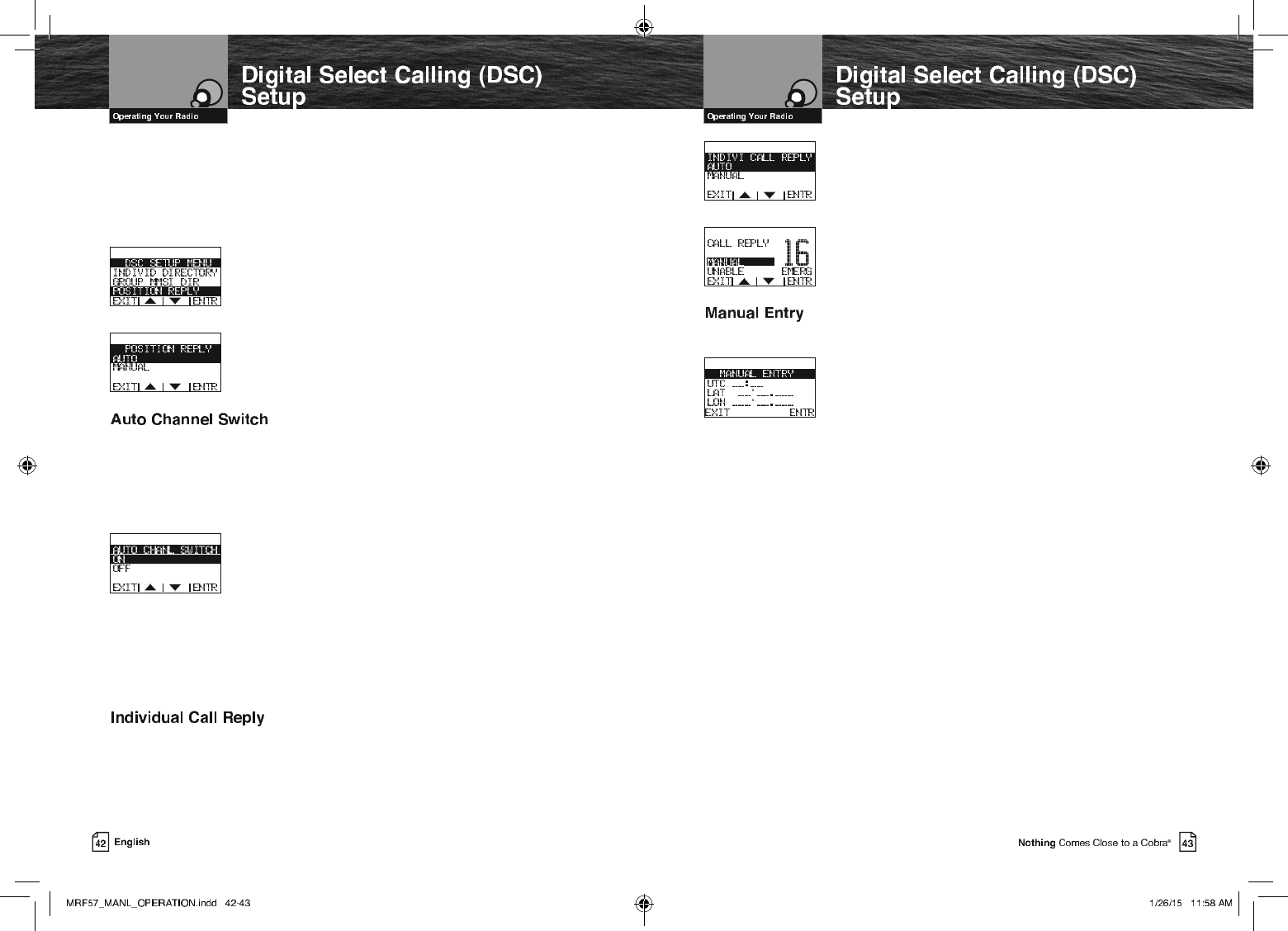
3RVLWLRQ5HTXHVW5HSO\7\SH
The ability to send your position to another station is an added feature of DSC radios that have
GPS attached. It is handy for rendezvous and rescue situations.
Your CobraMarine VHF radio allows you to choose whether to have the radio automatically
respond to all Position Requests it receives or to alert you to a Position Request and allow
you to choose whether to respond or not — manual reply.
To Set The Position Request Reply Type:
1. Enter the DSC SETUP MENU menu and scroll to
POSITION REPLY with the Up/Down soft keys or the
UP/Down channel buttons.
2. Press the ENTR soft key and observe the current
highlighted setting — AUTO or MANUAL.
3. Use the Up/Down soft keys or the Up/Down channel
buttons to change the setting.
4. Press the ENTR soft key to select the setting and return
to the DSC SETUP MENU.
The ability of your radio to automatically switch to the requested channel when receiving
an Individual Call. In some cases, automatically switching channels may not be wanted,
especially if the radio is being used for Bridge to Bridge communications in a busy port
or waterway.
Your CobraMarine VHF radio allows you to choose whether to have the radio automatically
Change channels to the requested channel in an Individual Call or not.
To Set The Automatic Channel Switch On or Off:
1. Enter the DSC SETUP MENU menu and scroll to AUTO
CHANNL SWITCH (Automatic Channel Switch) with the Up/
Down soft keys or the UP/Down channel buttons.
2. Press the ENTR soft key and observe the current highlighted
setting — ON or OFF.
3. Use the Up/Down soft keys or the Up/Down channel buttons
to change the setting.
4. Press the ENTR soft key to select the setting and return to
the DSC SETUP MENU.
The Individual Call Reply feature is used when receiving Individual DSC calls. When receiving a
Individual DSC Call, you may not want the radio to reply to the call automatically. This features
allows you to disable the automatic reply. The ability to send your position to another station
is an added feature of DSC radios that have GPS attached. It is handy for rendezvous and
rescue situations.
To Set The Individual Reply Auto or Manual:
1. Enter the DSC SETUP MENU menu and scroll to
INDIVID CALL REPLY (Individual Call Reply) with the
Up/Down soft keys or the UP/Down channel buttons.
2. Press the ENTR soft key and observe the current
highlighted setting — AUTO or MANUAL.
3. Use the Up/Down soft keys or the Up/Down channel
buttons to change the setting.
4. Press the ENTR soft key to select the setting and return
to the DSC SETUP MENU.
The Manual position entry feature allow you to enter the time (UTC time), Latitude and
Longitude.
To Enter the Time, Latitude, and Longitude:
1. Enter the DSC SETUP MENU menu and scroll to MANUAL ENTRY
with the Up/Down soft keys or the UP/Down channel buttons.
2. The cursor will begin to blink at the rst number of the
UTC time entry.
3. Use the Up/Down soft keys or the Up/Down channel buttons to scroll through the
number list.
4.
Press the ENTR soft key to select a number. This will also move the blinking cursor to the
next number under UTC Time.
5. Repeat steps 5 and 6 to enter additional numbers.
6. After entering the UTC time, press the ENTR soft key to move the blinking cursor to the
rst number under LAT (Latitude).
7. Use the Up/Down soft keys or the Up/Down channel buttons to scroll through the
number list.
8. Press the ENTR soft key to select the rst number and move the cursor to the next
number under LAT.
9. Repeat steps 9 and 10 until the seventh (7) digit of the LAT is entered.
10.
After entering the LAT (Latitude), press the ENTR soft key to move the blinking cursor to the
rst number under LON (Longitude).
11. Use the Up/Down soft keys or the Up/Down channel buttons to scroll through the
number list.
12. Press the ENTR soft key to select the rst number and move the cursor to the next
number under LON.
13.
Repeat steps 9 and 10 until the eighth (8) digit of the LON is entered.
14.
Press the ENTR button to save the entry and the radio will return to the DSC SETUP MENU.
MENU EXIT: You can exit the menu at any time by pressing the EXIT soft key on any screen. This
method will exit to the next highest menu, repeated presses of the EXIT soft key will return the
radio to the radio standby mode. The menu EXIT selection in the menu screen will return the radio
immediately to the radio standby mode. When in the menu, just scroll down until the EXIT option is
highlighted, then press the ENTR soft key.
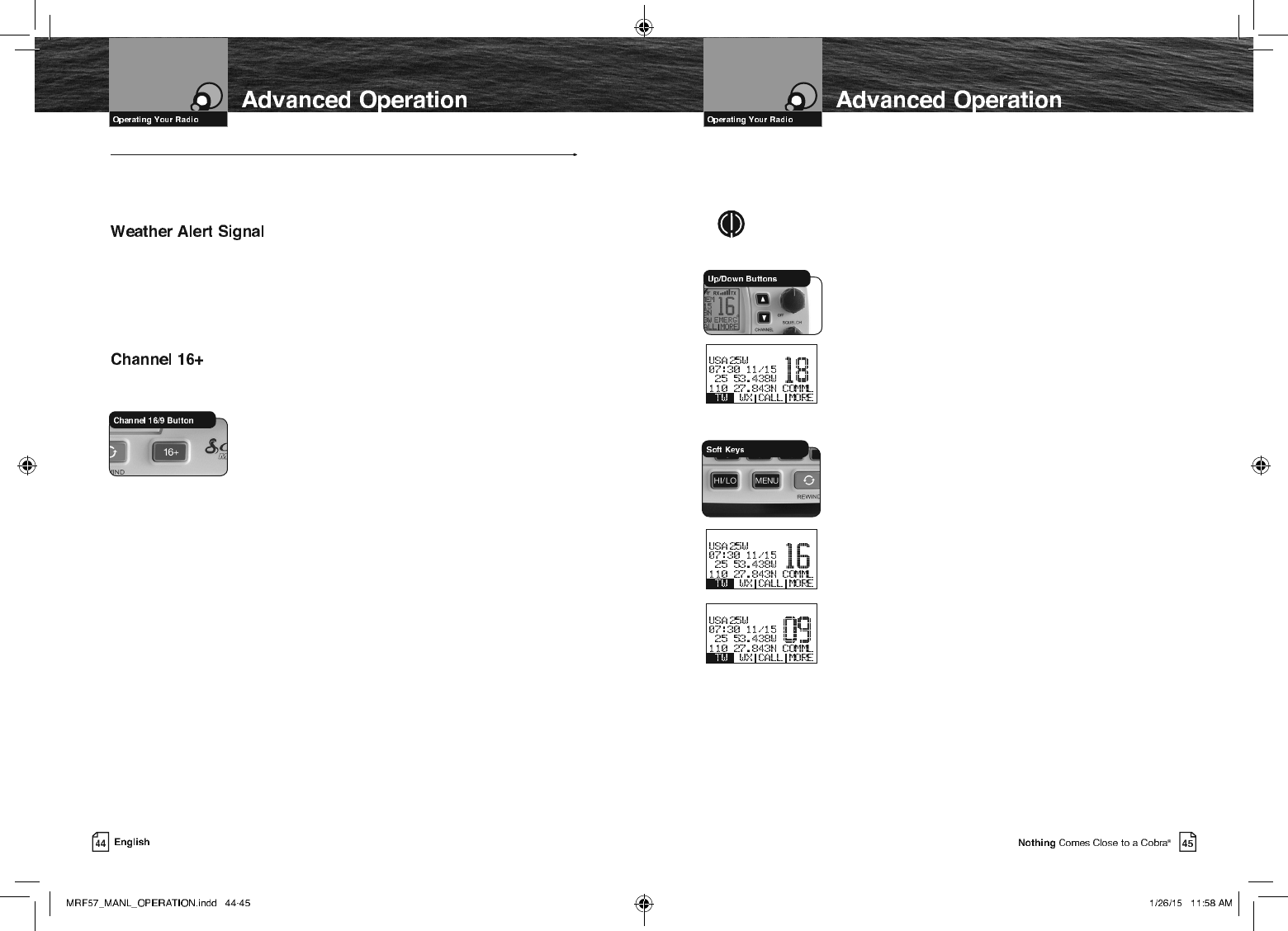
Advanced Operation
Cobra® has incorporated several features in your CobraMarine VHF radio to give you quick
access to the voice calling channels and to let you monitor more than one (1) channel at
once.
When NOAA broadcasts a Weather Alert Signal and your radio is in the Weather Alert mode,
you will hear a continuous audible tone and the radio will automatically switch to Weather
Radio mode. The alert indicators will sound regardless of what channel you are operating on
as soon as a NOAA alert signal is received.
When You Hear The Alert:
1. Press any key to turn Off the alert alarm and LCD indicator.
This function gives you quick access to calling Channel 16 or Channel 9 from any
operational mode.
To Switch To Channel 16 Or Channel 9:
1. Press the Channel 16+ button to change to Channel 16 from
any channel.
2. Press the Channel 16+ button again to change to Channel 9.
Additional presses of the Channel 16+ button will toggle back to
the original channel and between channels 16 and 9.
7UL:DWFK
Tri-Watch gives you one (1) soft key access to scan the three (3) channels of most importance
to you. Channel 16 and Channel 9 will always be included as scanned channels. The
remaining channel will be the VHF channel in effect when you enter Tri-Watch mode.
NOTE
The radio must be squelched for tri-watch to function. See page 26 for
squelch procedure.
To Enter Tri-Watch Mode:
1. In Standby mode, use the Up/Down buttons to go to the
channel you want to add as the third location to be scanned.
2. Press the Tri-Watch soft key.
Tri-watch will be indicated on the LCD and the radio will scan
between Channel 16, Channel 9, and the third tri-watch channel
you selected. A signal on any one (1) of the three (3) channels
will stop the scan to allow you to listen to the trafc on the
channel. The channel number will be displayed on the LCD.
To Exit Tri-Watch Mode:
1. Press the Tri-Watch soft key. The radio will return to
Standby mode
During Tri-Watch (while receiving an incoming transmission),
You Can Choose From The Following:
a. Press the Talk button to remain on that tri-watch channel and
return to Standby mode.
If you do not press any buttons, your radio will automatically
resume scanning tri-watch channels when the incoming
transmission is complete.
During Tri-Watch (while not receiving a transmission):
a. Press the Talk button to communicate on the last tri-watch
channel scanned and return to Standby mode.
o
o
o
o
o
o
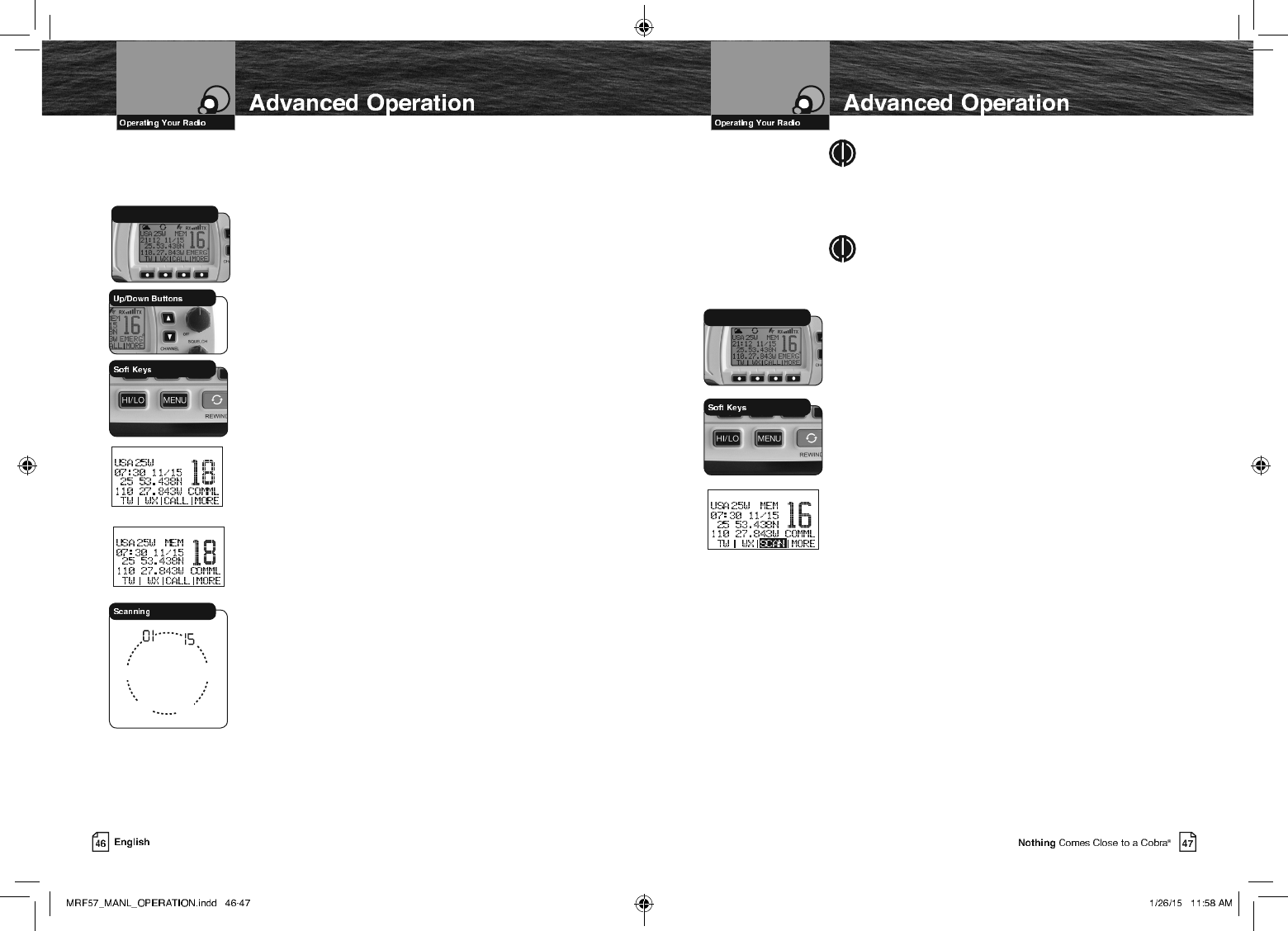
0HPRU\&KDQQHOV
You can program (or tag) any or all channels to be scanned in the Memory
Scan mode.
To Program Memory Channels:
1. From Standby mode, select a channel to be tagged using
the Up/Down buttons.
2. Press the MORE soft key (if necessary), then the MEM
soft key. The channel will be tagged for scanning and
MEM (memory channel) will appear on the LCD whenever
that channel is selected.
Repeat steps 1 through 2 to add addition memory
channels.
To Clear Memory Channels:
1. From Standby mode, select a channel to be cleared
from a memory tagging using the Up/Down buttons.
2. Press and hold the MORE soft key (if necessary), then
the MEM soft key. The channel will be untagged and
MEM (memory channel) will no longer appear on the LCD
whenever that channel is selected.
Repeat steps 1 through 2 to clear additional channels
from memory locations.
0HPRU\6FDQ
During Memory Scan, the radio will rapidly switch from
tagged channel to tagged channel. Whenever any activity is
detected, the radio will stop the scan to allow you to listen
to the activity on that channel. The radio will then continue
to scan after 2 seconds of inactivity, unless you switch out of
the Memory Scan mode.
88 30
60
75
o
o
o
o
NOTE
If there are fewer than two (2) channels tagged,
the Memory Scan mode will not be available.
[See page 47 under program memory channels
to tag at least two (2) channels.]
NOTE
The radio must be squelched for the Memory Scan mode
to function. See page 26 for squelch procedure.
To Enter Memory Scan:
1. From Standby mode, press the MORE soft key (if
necessary), then the SCAN soft key.
The radio will immediately begin to scan the channels you
tagged. SCAN (memory scan) will be highlighted on the LCD.
To Exit Memory Scan:
1. From Memory Scan mode, press the SCAN soft key.
This will return the radio to Standby mode on the last
scanned memory location.
During Memory Scan (while receiving an incoming
transmission), You Can Choose From The Following:
a. Press the Talk button to remain on that memory
location and end scanning. This will return the radio
to Standby mode.
The radio will then continue to scan after 2 seconds of
inactivity, unless you switch out of the Memory Scan
mode.
During Memory Scan (while not receiving a
transmission):
b. Press the Talk button to communicate on the last
channel scanned and return to Standby mode.
6WDQGE\0RGH
6WDQGE\0RGH
o
o
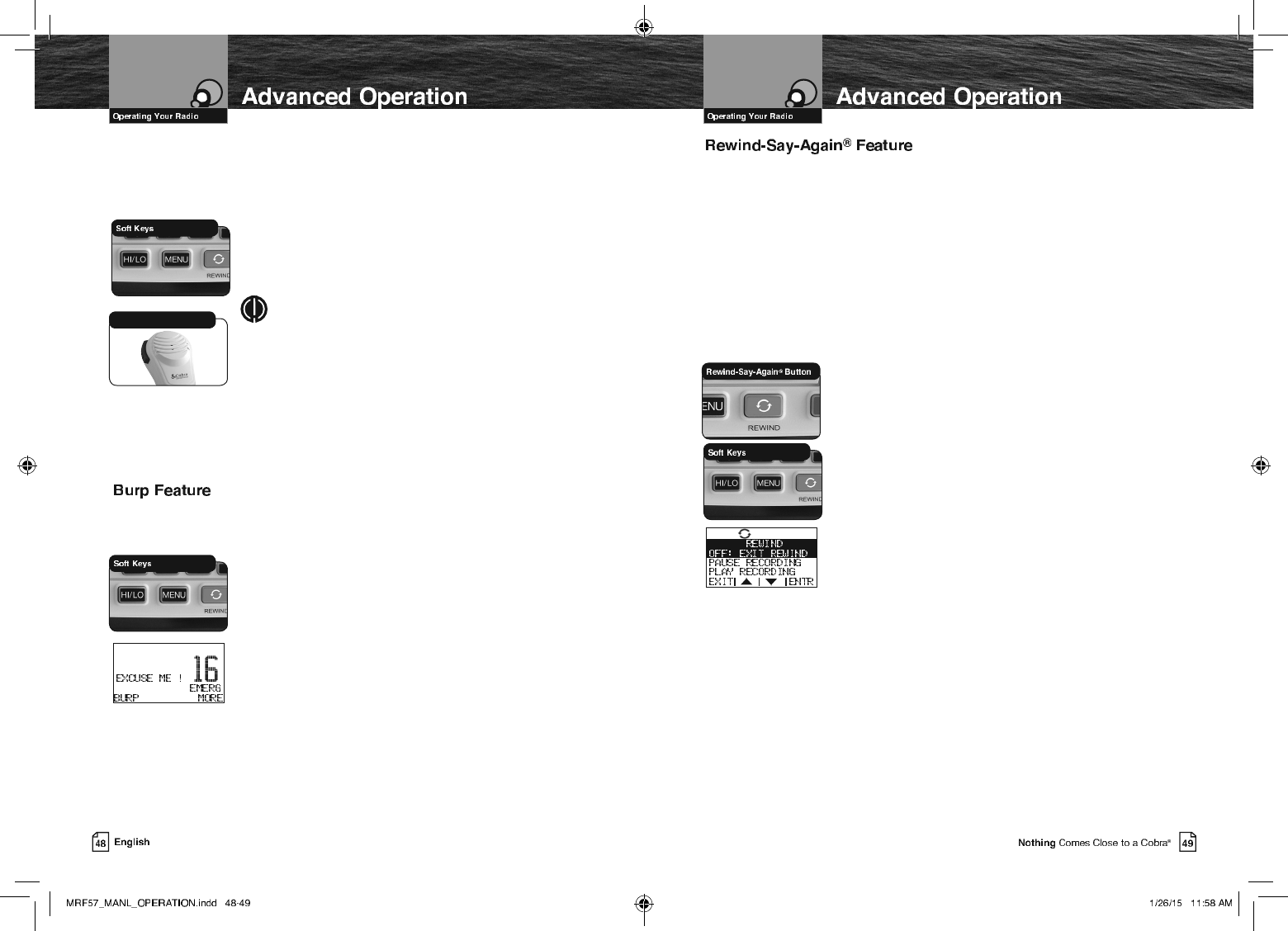
3XEOLF$GGUHVV
Use the Public Address (PA) mode of voice transmission to communicate to other
nearby vessels or people. This feature requires a mounted and connected optional PA
speaker.
To Broadcast on the PA Speaker:
1. Press the PA soft key.
2. Press the Talk button on the microphone and speak into
the microphone.
NOTE
While in the PA mode:
Q When the Talk button is pressed, the output is
directed to the PA speaker and not transmitted
as a radio signal through the antenna.
Q Received radio messages will not be heard while the PA
mode is active.
3. To turn off PA, press PA soft key again.
Cobra’s Burp feature allows the operator to expel water from inside the speaker
grill. This is especially useful if the radio is Sprayed or during extreme foul weather
conditions. In these conditions, water can become trapped in the speaker grill and
mufe the audio.
To Activate Burp:
1. Press the BURP soft key.
2. The Burp tone(s) at maximum level will sound from the
internal speaker for ve seconds.
3. During this time, the matrix will display EXCUSE ME !.
4. After a 5-second interval, the radio will return to standby
7DON%XWWRQ
The radio has a Cobra exclusive playback feature, Rewind-Say-Again®. This feature allows
you to replay the last 20 seconds of an incoming audio transmission. It also allows you to
record call details including position coordinates, call signs, registration numbers and store
details that will help authorities locate a distressed vessel.
Example 1:
When engine noise, music or conversation creates too much noise to hear an inbound
message clearly, press the Rewind-Say-Again® button to enter the Rewind-Say-Again®
menu to be able to hear the message a second time. This feature eliminates asking the
sender to repeat the message.
Example 2:
When listening to an urgent distress of an excited caller with confusing background noise,
press the Rewind-Say-Again® button to enter the Rewind-Say-Again® menu to be able to
hear the message a second time and get lifesaving information.
Operation of Rewind-Say-Again®
1. Press the Rewind button after the last inbound audio
transmission.
2. Using the Up/Down soft keys or the channel Up/Down
buttons scroll to the PLAY RECORDING menu option.
3. Press the ENTR key to hear the recording.
4. The radio automatically replays the last 20 seconds of the
previous audio transmission.
5.
Respond to the caller normally, after the message is replayed.
Setup and Advanced Operation of Rewind-Say-Again
®
Operation of Rewind-Say-Again®:
1. Press the Rewind button.
a. OFF: EXIT REWIND - When highlighted and the ENTR key is
pressed, exits the Rewind features and when the Rewind
button is pressed again, the screen above will be displayed.
b. PAUSE RECORDING - Pause recording of incoming
audio transmissions.
c. PLAYBACK RECORDING - Playback recorded incoming audio.
d. SAVE RECORDING - Saves recorded incoming audio.
e. ERASE RECORDING - Erases the saved recording.
f. RECORD MESSAGE - Record a message (using the
microphone to record the message, using the PTT key
to start and stop the recording).
g. PLAYBACK MESSAGE - Playback the recorded message.
h. SAVE MESSAGE - Save the recorded message.
i. ERASE MESSAGE - Erases the saved message.
j. TRANSMIT MESSAGE - Transmit the recorded message.
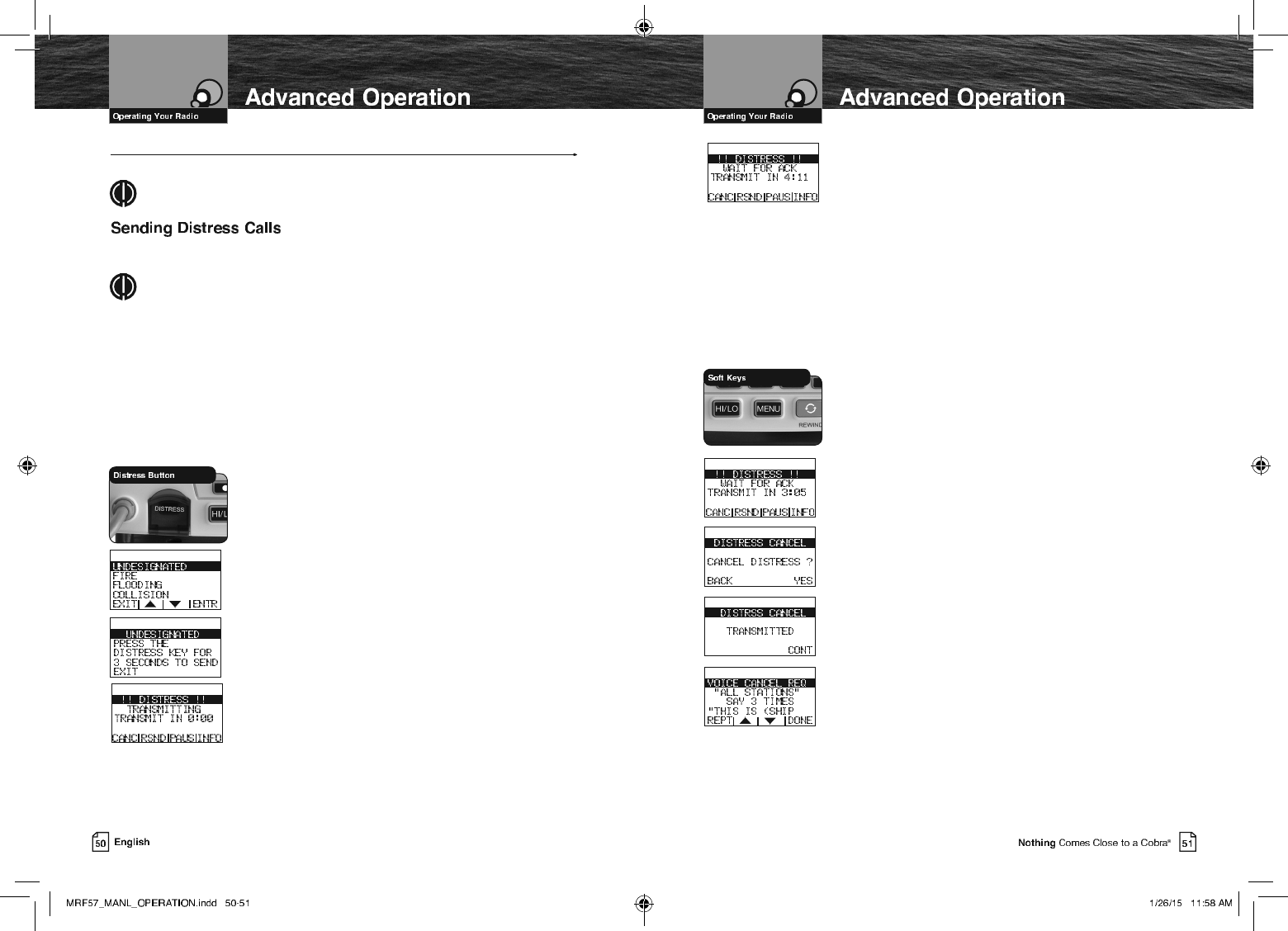
Abort The Distress Call Process:
If the Distress button is pressed by mistake:
a. Press the EXIT soft key to return to Standby mode.
The Distress alarm sounds to conrm that the message is
transmitted. At the end of the transmission, the radio
maintains a watch on Channel 16 and Channel 70 for an
acknowledgement. Press any button to turn Off the alarm.
Q If an acknowledgement is received, the Distress alarm
sounds again and the responding party’s MMSI number
displays on the LCD.
Q If no acknowledgement is received, the radio resends
the message at approximately four (4) minute intervals
until an acknowledgement is received or the Distress
call is aborted.
Cancelling a Distress Call
At anytime Before receiving a Distress Call Acknowledgement,
the Distress can be canceled.
1.
From the WAIT FOR ACK screen, press the CANC soft key.
2. From the DISTRESS CANCEL screen, conrm cancelling
the Distress Call by pressing the YES soft key.
3. After the Distress Call Cancel message has been sent,
press the CONT key.
4. After the Distress Cancel has been sent, your are required
to follow-up with a VOICE CANCEL containing the
following information:
“ALL STATIONS” SAY 3 TIMES
“This is (SHIP NAME), (CALL SIGN), (SHIP MMSI #),
(POSITION)” CANCEL MY DISTRESS ALERT OF “(DATE,
UTC TIME)”
5. After completing the VOICE CANCEL procedure, press the
DONE soft key to return to the radio idle screen.
Digital Select Calling (DSC) Operation
The Send menu displays when the Distress button is pressed.
NOTE
This radio follows Class-D DSC protocol with a dedicated Channel 70 receiver.
Sending and receiving distress calls and acknowledgements on Channel 70 can be a
lifesaver for mariners.
NOTE
The DSC call:
QSound the distress alarm at all receiving stations.
Q Inform receiving stations of your identity (MMSI).
Q Informs receiving stations of the nature of the emergency.
Q Informs receiving stations of sending position when a GPS device is connected
or a position is manually entered. DSC operation does not provide receiving
stations with information like number of persons aboard or injuries. This
specic information must be communicated by voice on Channel 16 to the
station that acknowledges a DSC Distress call.
To Send a DSC Distress Call:
1. From Standby mode, pull down the spring-loaded red
door on the transceiver and press the Distress button.
You will have three (3) choices:
Q Send a distress call automatically, with your position,
if you are connected to a GPS. Or send the call, without
your position, if not connected to a GPS.
Q
Include a Nature of Distress message with the distress call.
Q Cancel the distress call process and return to
Standby mode.
2. Choose one of the following:
Send an Automatic Distress Call:
a. Press and hold the Distress button.
Include a Nature of Distress Message with Distress Call:
a. Press and release the Distress button.
b. Press the Up/Down soft keys or the Channel Up/
Down buttons to manually select from the list of
pre-programmed Nature of Distress calls —
UNDESIGNATED, FIRE, FLOODING, COLLISION,
GROUNDING, more.
c. Press and hold the Distress button for three (3)
seconds to transmit the distress signal.
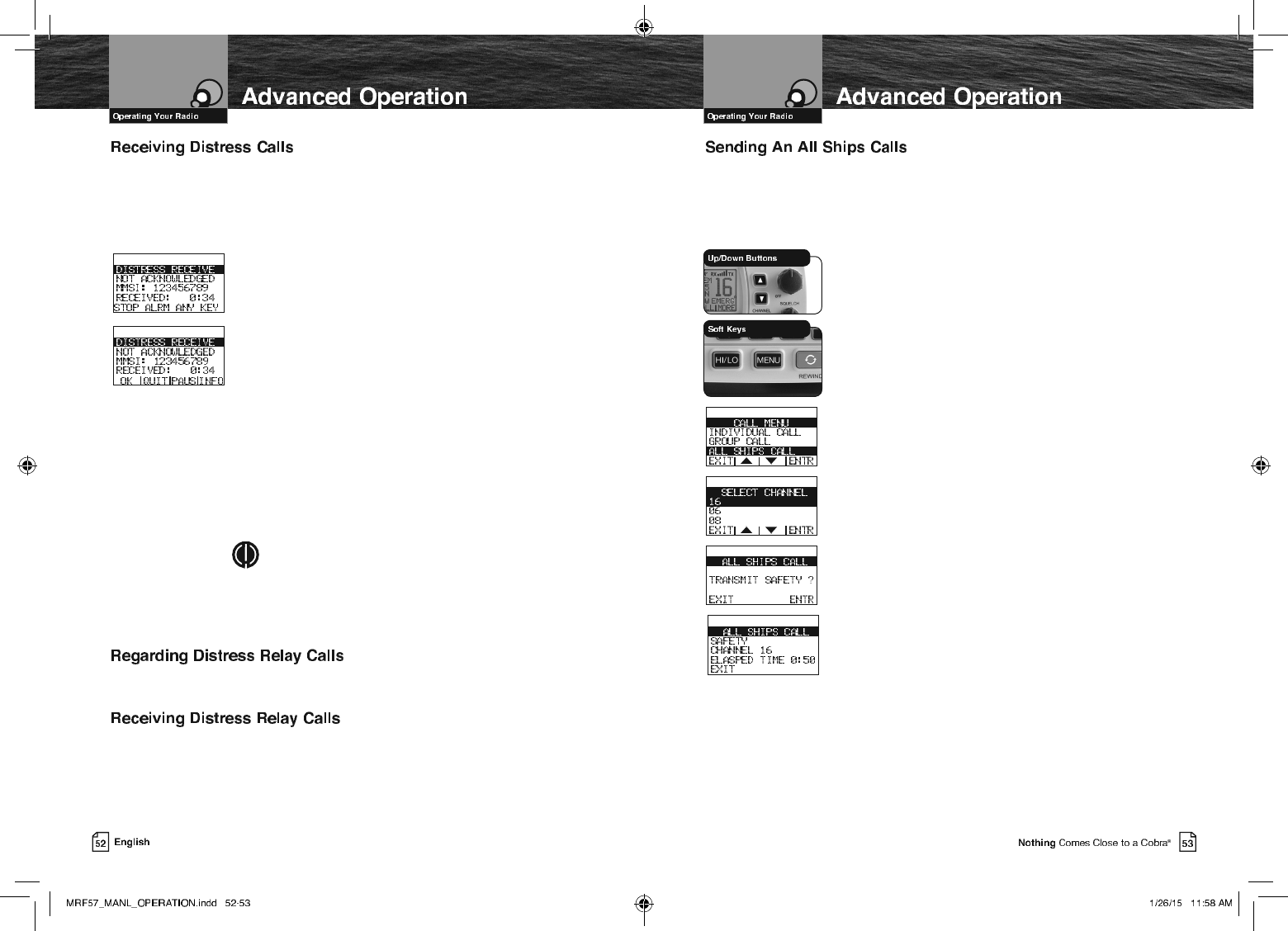
When a vessel is within range of a DSC Distress call, the radio receives the call,
sounds the Distress alarm, and switches to Channel 16. All DSC calls that are received
will sound one (1) alert alarm. See pages 10-13 for descriptions of the different
alarms. Press any button to turn Off the alarm. The received call information continues
to display on the LCD.
When A Distress Call Is Received:
1. Press any button to turn Off the alarm.
2. Read and write down the distress information that
displays on the LCD (position data may or may not be
shown); then determine whether to answer the call.
3. Respond, if appropriate, by pressing and holding the Talk
button to transmit on Channel 16.
4.
The received information is placed into the Call Log.
See page 62 for more information on viewing the Call
Waiting Log.
5.
If MMSI (Maritime Mobile Service Identify) matches a
contact from the Individual Directory entry stored in your
radio, the name identication displays and the alarm
sounds to identify the Name of the matching MMSI member.
6. Press ESC after viewing the display to return to normal
Standby mode.
NOTE
The radio automatically switches to Channel 16 upon
receiving a DSC Distress call and the alarm will sound for
approximately two (2) minutes. Press any button to clear
the Distress alarm instantly.
This radio cannot send Distress Relay calls. Only large ships and shore stations, with
specially equipped radios, can send Distress Relay calls.
This radio does respond to a Distress Relay call just as it responds to a Distress call.
Use the DSC All Ships call for the same urgency and safety purposes as the Pan and
Securite voice calls as well as sending Routine messages to all stations at once.
The DSC All Ships call reaches all stations in radio range. Use the DSC All Ships call
for urgent, but not life-threatening situations or to broadcast a safety warning to all
vessels in the area.
To Send An All Ships Call:
1. Press the CALL soft key and scroll to ALL SHIPS
CALL with the UP/Down soft keys or the channel Up/
Down buttons.
2. Select either SAFETY or URGENCY and press the ENTR
soft key.
3. Using the Up/Down soft keys or the channel Up/Down
buttons, select the voice channel all radios will tune to
after the All Ships message is sent and press the ENTR
key.
4. Press the ENTR soft key to send the All Ships Call.
5. The radio will tune to the voice channel previously
selected.
6. Press the EXIT soft key to exit the All Ships Call mode
and return the radio to the idle screen.
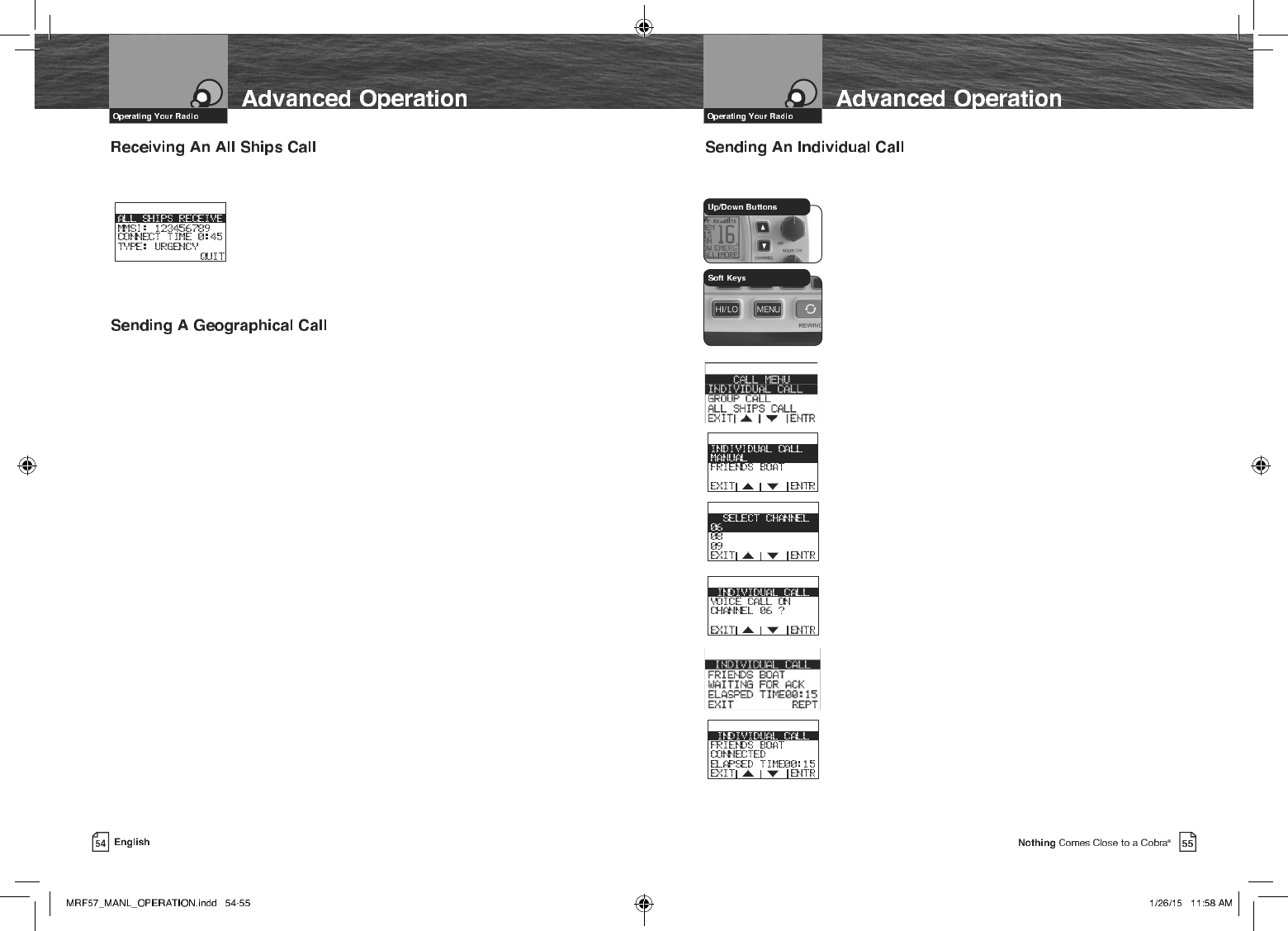
All Ships calls received from stations within range of the radio sound the Distress
alarm and switch the radio to Channel 16.
When An All Ships Call Is Heard:
1. Press any button to turn Off the alarm.
2. Read and write down the MMSI of the vessel sending
the call as well as the date and time of the call.
3. Listen to the incoming voice message on the channel the
radio selects for the incoming All Ships call.
This radio does not send Geographical calls. Only large ships and shore stations with
specially equipped radios send Geographical calls.
Use the DSC Individual call feature to request communication with one (1) exclusive
station. The DSC Individual call does not alert all other stations within range.
To Send An Individual Call:
1. Press the CALL soft key and scroll to INDIVIDUAL
CALL with the UP/Down soft keys or the channel Up/
Down buttons and press the ENTR soft key.
2. Using the Up/Down soft keys or the channel Up/Down
buttons to highlight a previously entered directory entry
or use the MANUAL entry option.
3. Press the ENTR key.
4. Using the Up/Down soft keys or the channel Up/Down
buttons, select the voice channel all radios will tune to
after the Individual Call message is sent and press the
ENTR key.
5. Press the ENTR soft key to send the Individual Call.
6. The radio will tune to the voice channel previously
selected.
7. Press the EXIT soft key to exit the Individual Call mode
and return the radio to the idle screen.
Q If the radio called sends back an automatic DSC response
“able to comply,” the individual alarm will sound. Wait for
a voice message from the called station.
_ Q If an “unable to comply” response or no reply is received,
the radio display asks to resend the message or exit the
menu. At the Unavailable menu, Press REPT or EXIT soft
keys.
_ Q If REPT is selected, the radio restarts the individual call.
Q If EXIT is selected, the radio will return to the Call Menu.
_
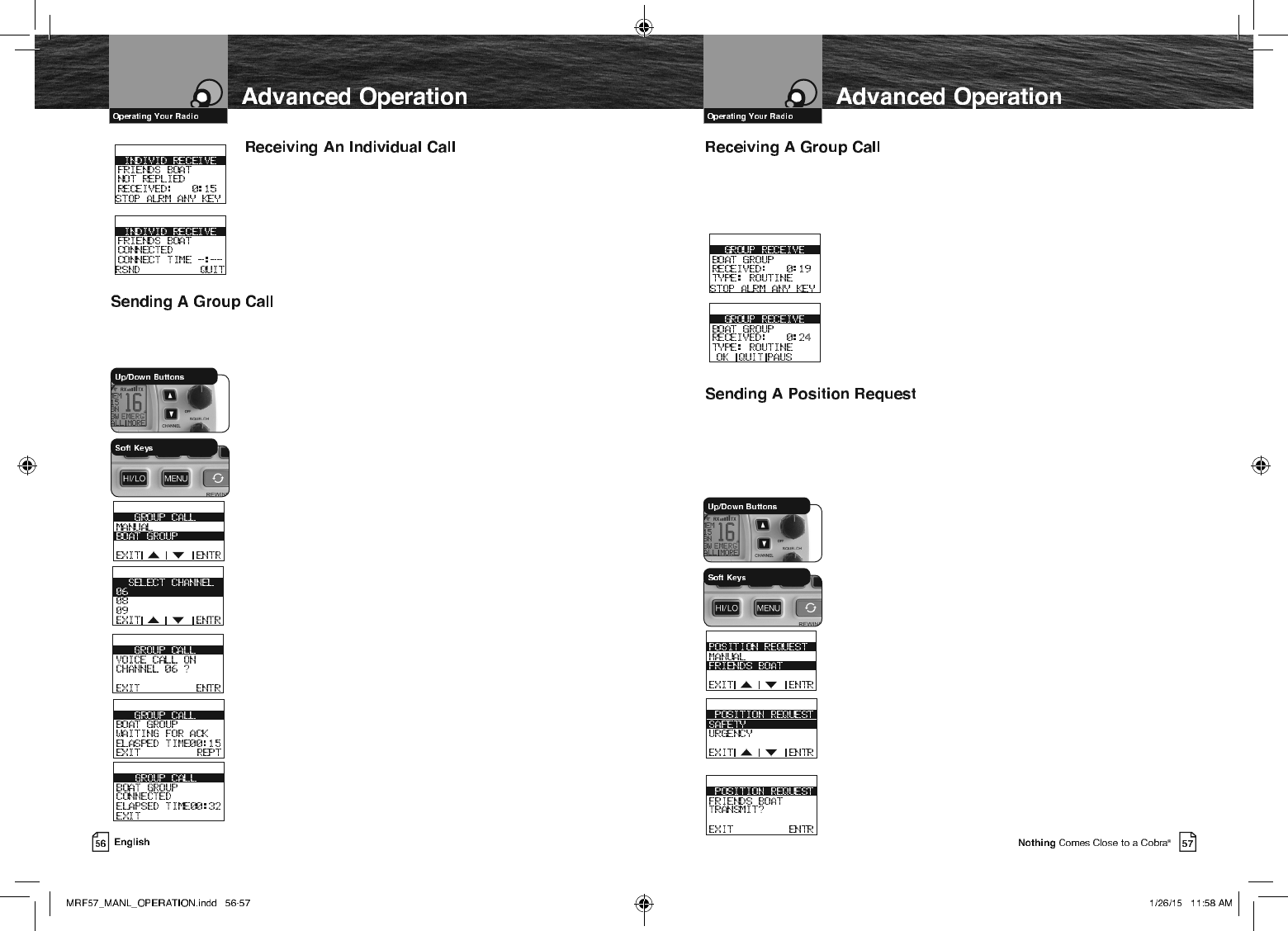
When another station makes an Individual call to your radio:
Q The Individual alarm sounds.
_ Q The caller is identied on the LCD.
Q If Automatic Channel Switch is on, the radio switches to
the channel selected by the caller.
Q Call information is placed in the Call Log.
To Receive An Individual Call:
Press the Talk button and greet the caller.
Sending a Group call is like sending an Individual call, but the group MMSI information
is used and the resend and DSC responses do not apply. See pg. 41 for creating and
entering a group MMSI.
To Send A Group Call:
1. Press the CALL soft key and scroll to GROUP CALL
with the Up/Down soft keys or the channel Up/Down
buttons and press the ENTR soft key.
2. Using the Up/Down soft keys or the channel Up/Down
buttons to highlight a previously entered directory entry
or use the MANUAL entry option.
3. Press the ENTR key.
4. Using the Up/Down soft keys or the channel Up/Down
buttons, select the voice channel all radios will tune to
after the Group Call message is sent and press the
ENTR key.
5. Press the ENTR soft key to send the Group Call.
6.
The radio will tune to the voice channel previously selected.
7. Press the EXIT soft key to exit the Group Call mode and
return the radio to the idle screen.
Q All radios switch to the channel selected in step 1. Press
and hold the Talk button to send a voice message to
everyone in the group.
Q Anyone in the group can transmit on the channel.
When another station makes a Group call to the radio, the Individual alarm sounds,
the caller is identied on the LCD, call information is placed in the Call Log, and the
radio is switched to the channel selected by the caller, similar to an Individual call.
Press any button to turn Off the alarm.
To Receive A Group Call:
1. Listen for the group voice message.
2. Press the Talk button and respond
only if appropriate.
Position Request mode enables a DSC radio to obtain the position (latitude and
longitude) of a station that has a GPS device connected to the DSC radio at that
station. In most cases, a reply will be forthcoming. If for some reason, your request is
not acknowledged in ve (5) minutes, the user will be prompted to Resend the request
or exit the menu.
To Request The Position Of Another Station:
1. Press the CALL soft key and scroll to POSITION
REQUEST with the Up/Down soft keys or the channel
Up/Down buttons and press the ENTR soft key.
2. Using the Up/Down soft keys or the channel Up/Down
buttons to highlight a previously entered directory entry
or use the MANUAL entry option.
3. Press the ENTR key.
4. Press the ENTR soft key to send the Position Request
Call.
5. The radio will show the WAITING FOR ACK screen
while waiting for the acknowledgement from the called
radio. And will show the ACKNOWLEDGED screen after
the called radio responds.
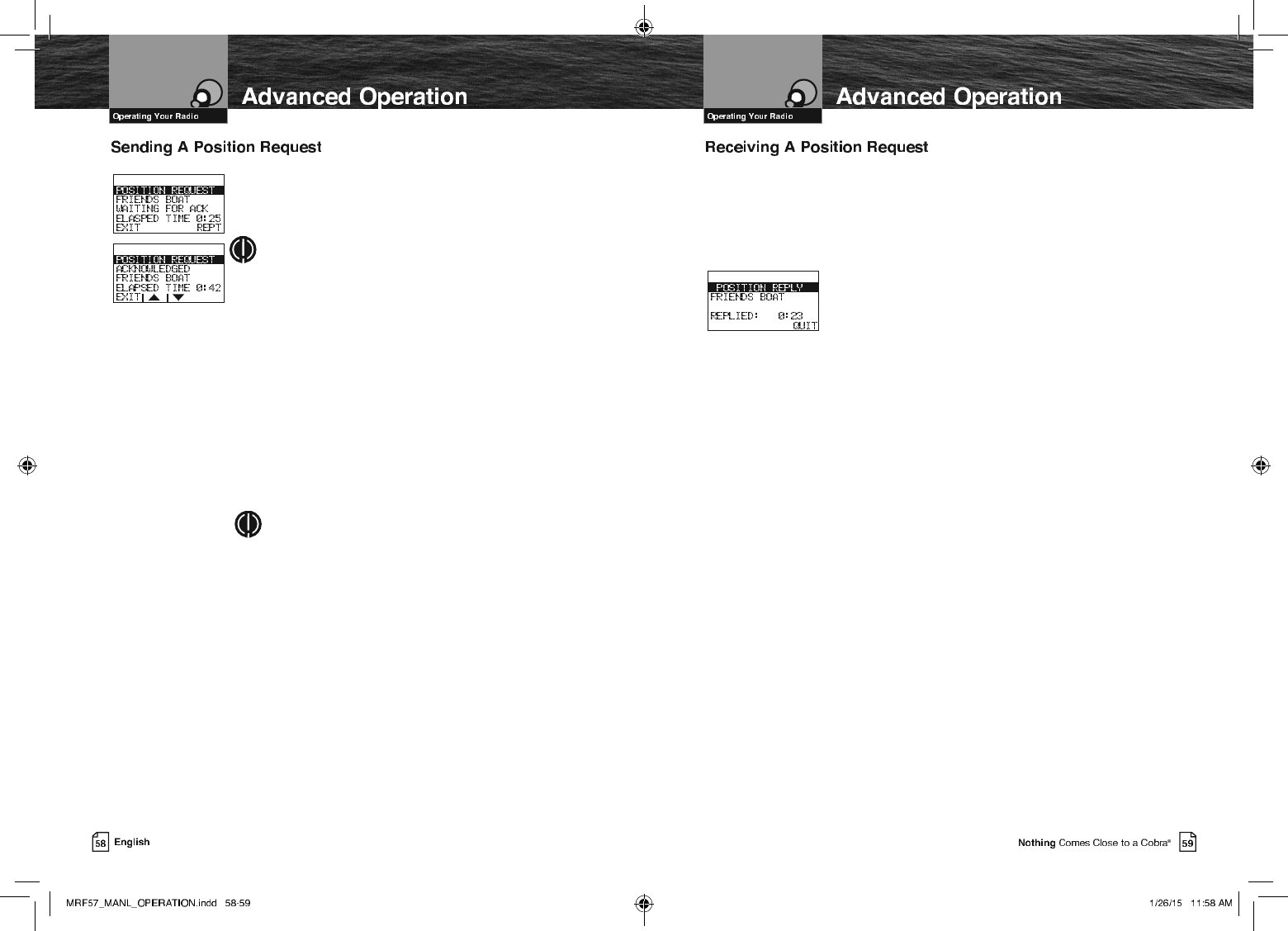
6. After the called radio acknowledges the call, use the
Down soft key to view the called radios current position.
7. Press the EXIT soft key to exit the Position Request mode
and return the radio to the Call Menu.
NOTE
Your radio will send the Position Request and there
will be one (1) of three (3) possible responses:
Q You will receive the position.
Q You will receive a no position data response,
meaning the station you queried is not connected
to a GPS device and cannot send its position.
Q You will receive a no reply response, meaning the
operator of that station has chosen not to reply
to your request.
If You Receive A Position:
The requested position with the station name
and MMSI will show on your screen.
Press the Enter button to return to Standby
mode after you have noted the station’s position.
NOTE
If the radio is connected properly to your chartplotter,
you will see the requested position of the other vessel
indicated on the display.
continued
When you went through the DSC set-up process, you set a position request reply type.
(See page 42 to change your setting.) Depending on the setting you chose, when a
Position Request message is received, your radio will enter either:
Q The Auto Reply mode.
Q The Manual Reply mode.
When The Radio Is In Auto Reply Mode:
A position request will sound the Position Request alarm and
show the name of the requesting station on the LCD. Your radio
will automatically respond. It will send your position, if you have
a GPS device connected to your radio, or NO POS. DATA (no
position data), if you do not have a GPS device connected.
Press any button to silence the alarm and exit the display.
When The Radio Is In The Manual Reply Mode:
A position request message will sound the Position
Request alarm and show the name of the requesting
station. You can choose to:
Q Reply and send your position.
Q Exit without sending your position.
If You Choose to Reply with Your Position:
1. Press the ENTR soft key.
If You Choose Not to Reply with Your Position:
2. Press the EXIT soft key.
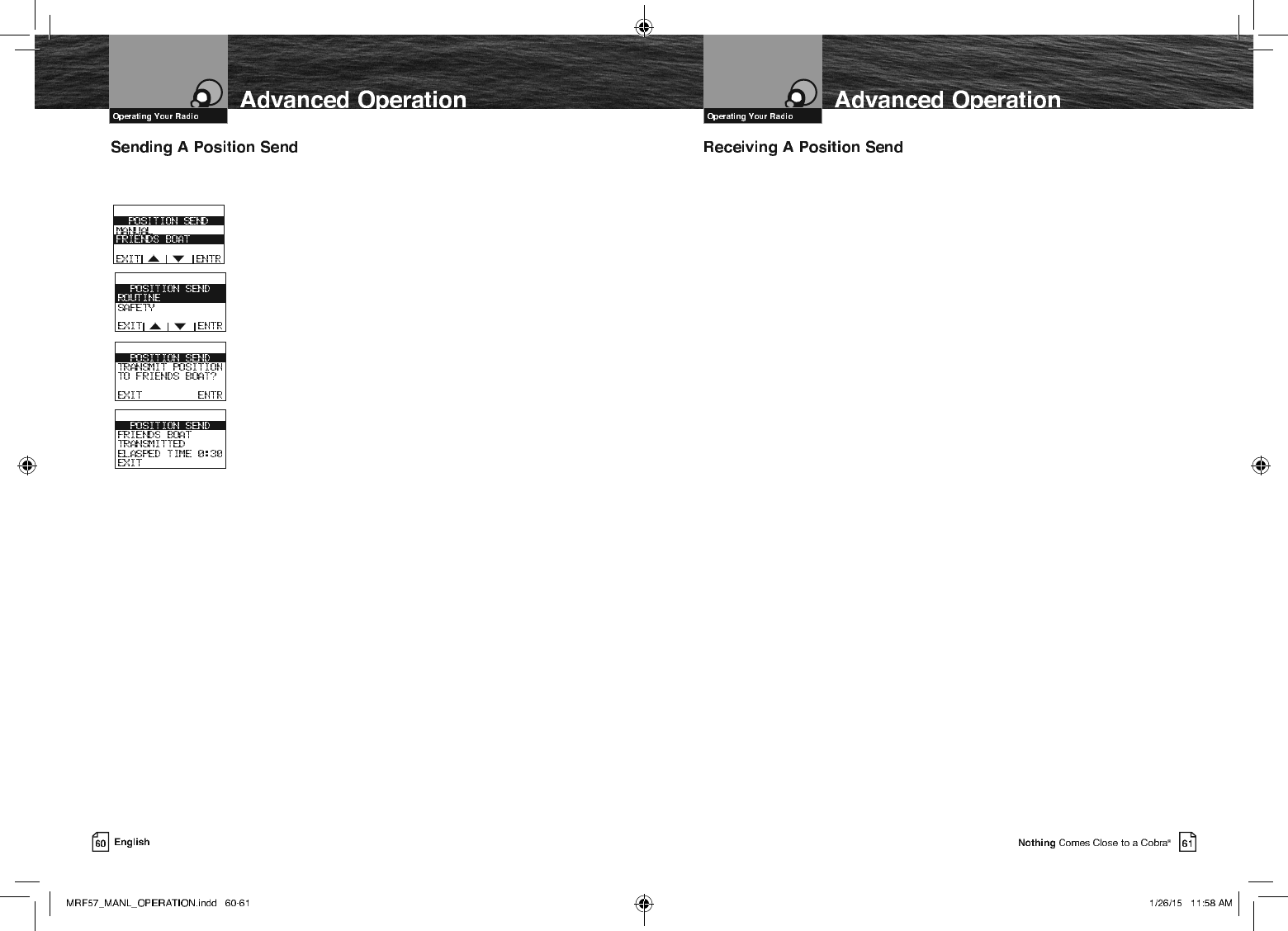
Position Send uses your connected GPS in similar fashion to the Position Request
function, except that you initiate the activity to let another station know where you are.
To Send A Position Send Message:
1. Press the CALL soft key and scroll to POSITION
SEND with the Up/Down soft keys or the channel Up/
Down buttons and press the ENTR soft key.
2. Using the Up/Down soft keys or the channel Up/Down
buttons to highlight a previously entered directory entry
or use the MANUAL entry option.
3. Press the ENTR key.
4. Press the ENTR soft key to send the Position SEND Call.
5. Press the EXIT soft key to exit the Position Send mode
and return the radio to the Call Menu.
When another station sends you its position in Position Send mode, the Individual
Alarm will sound and the station’s name and position will be shown
on the LCD. Press any button to turn Off the alarm and return to Standby mode.
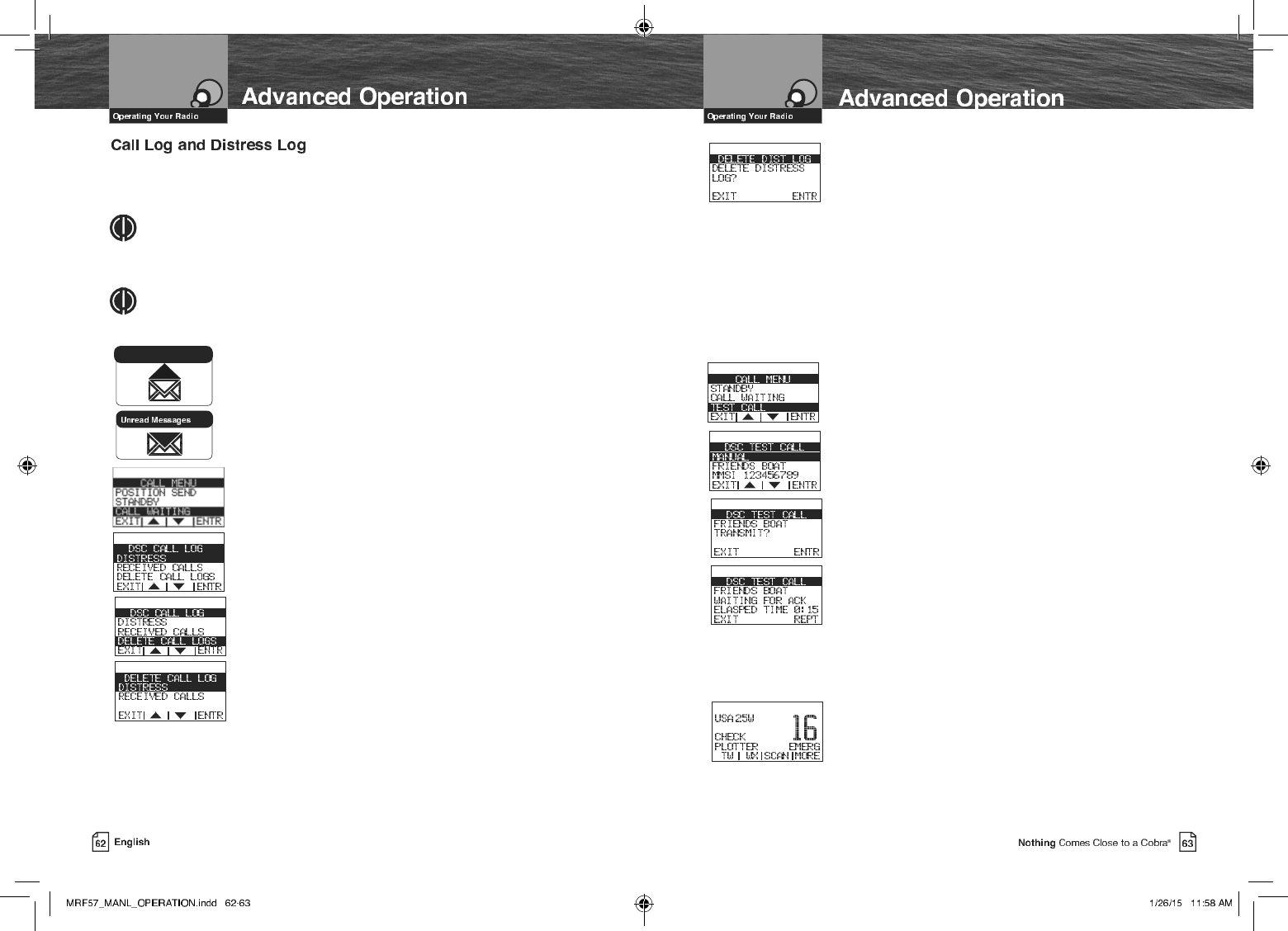
To Delete Call Log Information continued:
3. Press the ENTR key.
4. Using the Up/Down soft keys or the channel Up/Down
buttons to highlight DISTRESS or RECEIVED CALLS
log entry.
5. Press the ENTR key and conrm delete by pressing the
ENTR key.
6.
Press the EXIT soft key to exit the Position Send mode
and return the radio to the DELETE CALL LOGS Menu.
7HVW&DOO
The Test Call feature allows the user to conrm that the radio is fully operational and
that the DSC call functions are working properly.
1. Press the CALL soft key and scroll to TEST CALL with
the UP/Down soft keys or the channel Up/Down buttons
and press the ENTR soft key.
2. Using the Up/Down soft keys or the channel Up/Down
buttons to highlight a previously entered directory entry
or use the MANUAL entry option.
3. Press the ENTR key.
4. Press the ENTR soft key to send the Test Call.
5. The radio will tune to the voice channel previously selected.
6. Press the EXIT soft key to exit the Test Call mode and
return the radio to the Call Menu.
$ODUP,Q
Allows connection to the alarm output of your chart plotter to alert you when an
arrival, off-course, etc.alarm has been activated.
1. Connect the Blue wire on the back panel wire harness
to the Alarm Output of your plotter (see the operators
manual of your plotter for connection and use details).
2. When your plotter outputs the alarm signal (the plotter
grounds the alarm output), your CobraMarine radio will
activate the Alarm screen and sound a loud alarm tone.
3. Pressing any key on your CobraMarine radio will silence
the alarm.
Call Waiting functions similarly to the Caller ID function on your telephone. It will
capture the caller’s MMSI identication number and any other data included in a DSC
message.
NOTE
Each Call Log memory can hold up to 20 messages. Once the memory becomes
full, each new call will erase the oldest call information on a rst-in, rst-out
basis.
NOTE
The Envelope Icon will be displayed when calls are received and placed into any
of the call logs.
Q The envelope Icon will be shown closed to indicate
unread messages.
Q The envelope Icon will be shown open to indicate that all
messages have been read.
To Review Call Log Messages Received
While In DSC Standby Mode:
1. Press the CALL soft key and scroll to CALL WAITING
with the Up/Down soft keys or the channel Up/Down
buttons and press the ENTR soft key.
2. Using the Up/Down soft keys or the channel Up/Down
buttons to highlight DISTRESS LOG or RECEIVED CALLS
logs.
3. Press the ENTR key.
4. Using the Up/Down soft keys or the channel Up/Down
buttons to highlight a log entry.
5. Press the ENTR key to view the log entry.
6. Press the EXIT soft key to exit the Position Send mode
and return the radio to the DSC CALL LOGS Menu.
To Delete Call Log Information:
1. Press the CALL soft key and scroll to CALL WAITING
with the Up/Down soft keys or the channel Up/Down
buttons and press the ENTR soft key.
2. Using the Up/Down soft keys or the channel Up/Down
buttons to highlight DELETE CALL LOGS.
$OO0HVVDJHV9LHZHG
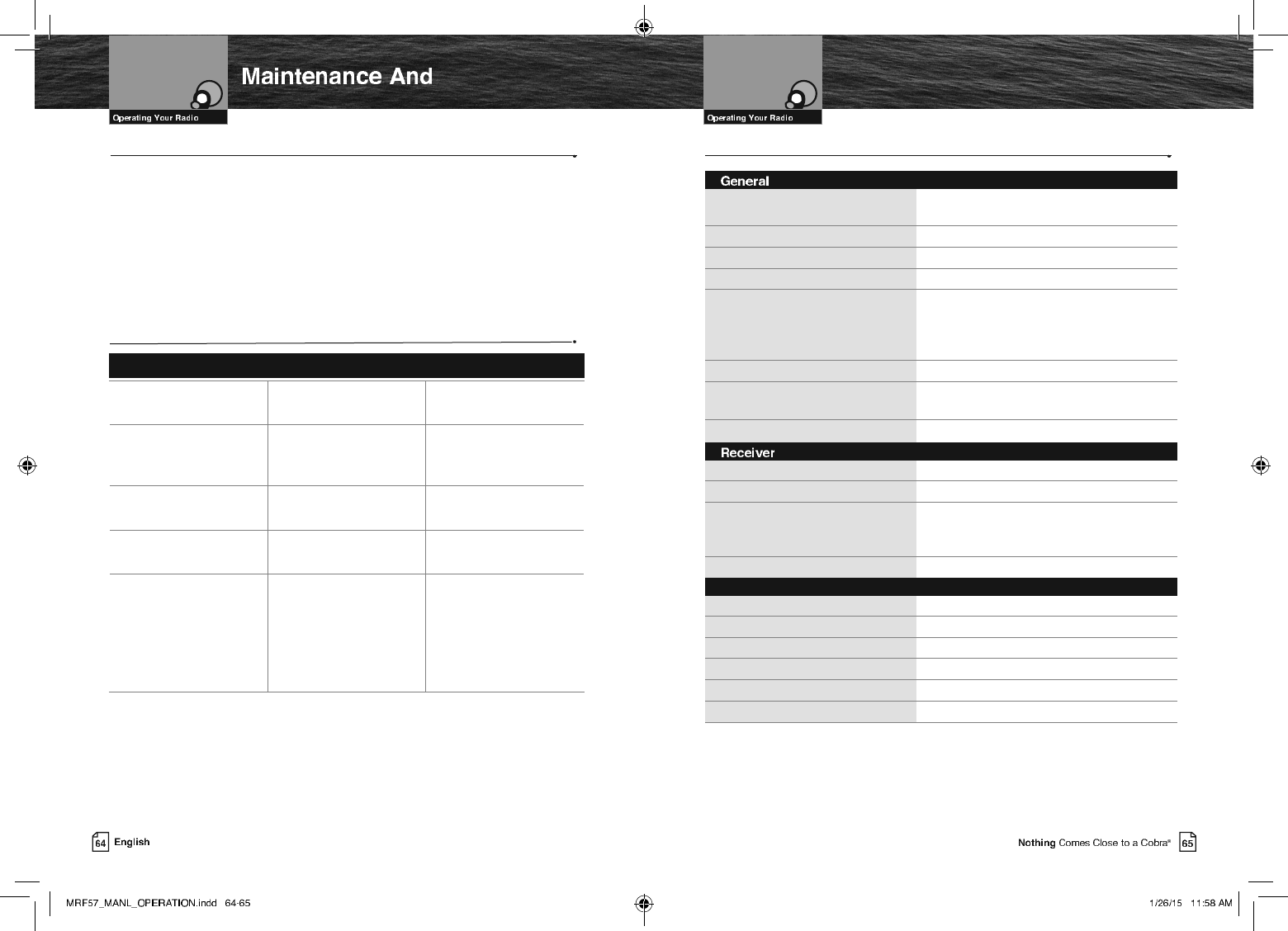
6SHFLÀFDWLRQV
Specications
Number of Channels All U.S.A., Canadian, and International
10 NOAA Weather Channels
Channel Spacing 25 kHz
Modulation 5 kHz Max.
Input Voltage 13.8 VDC
Current Drain:
Stand-by 20 mA
Receive 200 mA
Transmit 5A @ High power 1A @ Low
Temperature Range -20˚ C to 55˚ C
Unit Dimensions 6.25” x 3.0” x 6”
(15.9 cm x 5.7 cm x 18 cm)
Unit Weight 2 lbs., 12.0 oz. (1100 g)
Frequency Range 156.050 to 163.275 MHz
Receiver Type Double Conversion Super-Heterodyne
Sensitivity:
20 dB Quieting 0.35 uV
12 dB Sinad 0.30 uV
AF Output 2.5 Watts @ 8 Ohms
7UDQVPLWWHU
Frequency Range: TX 156.025 to 157.425 MHz
RF Output Power 1 and 25 Watts
Spurious Emissions -60 dB High -55 dB Low
Microphone Type Electret
Frequency Stability +/-10 ppm
FM Hum and Noise 40 dB
No display on LCD when
radio is turned On
Improper power
connection
Insure power connections
are proper and secure
Will transmit at
one (1) watt, but not
at 25 watts
Selected channel is
limited to one (1) watt
Switch to
another channel
Will not transmit Selected channel is
limited to receive only
Switch to
another channel
No sound from speaker Volume level is too low or
squelch level is too deep
Readjust volume
and squelch
No answer to calls Out of range of
other station
Signal is blocked
by terrain
Switch to high power
(25 watts) or move closer
Move until you have
a “line-of-sight” to
the other station
7URXEOHVKRRWLQJ
Problem Possible Cause(s) Solution(s)
Maintenance
Very little maintenance is required to keep your CobraMarine VHF radio in good
operating condition.
Q Keep the radio clean by wiping with a soft cloth and mild detergent.
Rinse with fresh water. Do not use solvents or harsh or abrasive cleaners,
which could damage the case or scratch the LCD screen.
Q If the radio is exposed to salt water, rinse it in fresh water at least once
a day to prevent build-up of salt deposits, which could interfere with
button operation.
Troubleshooting
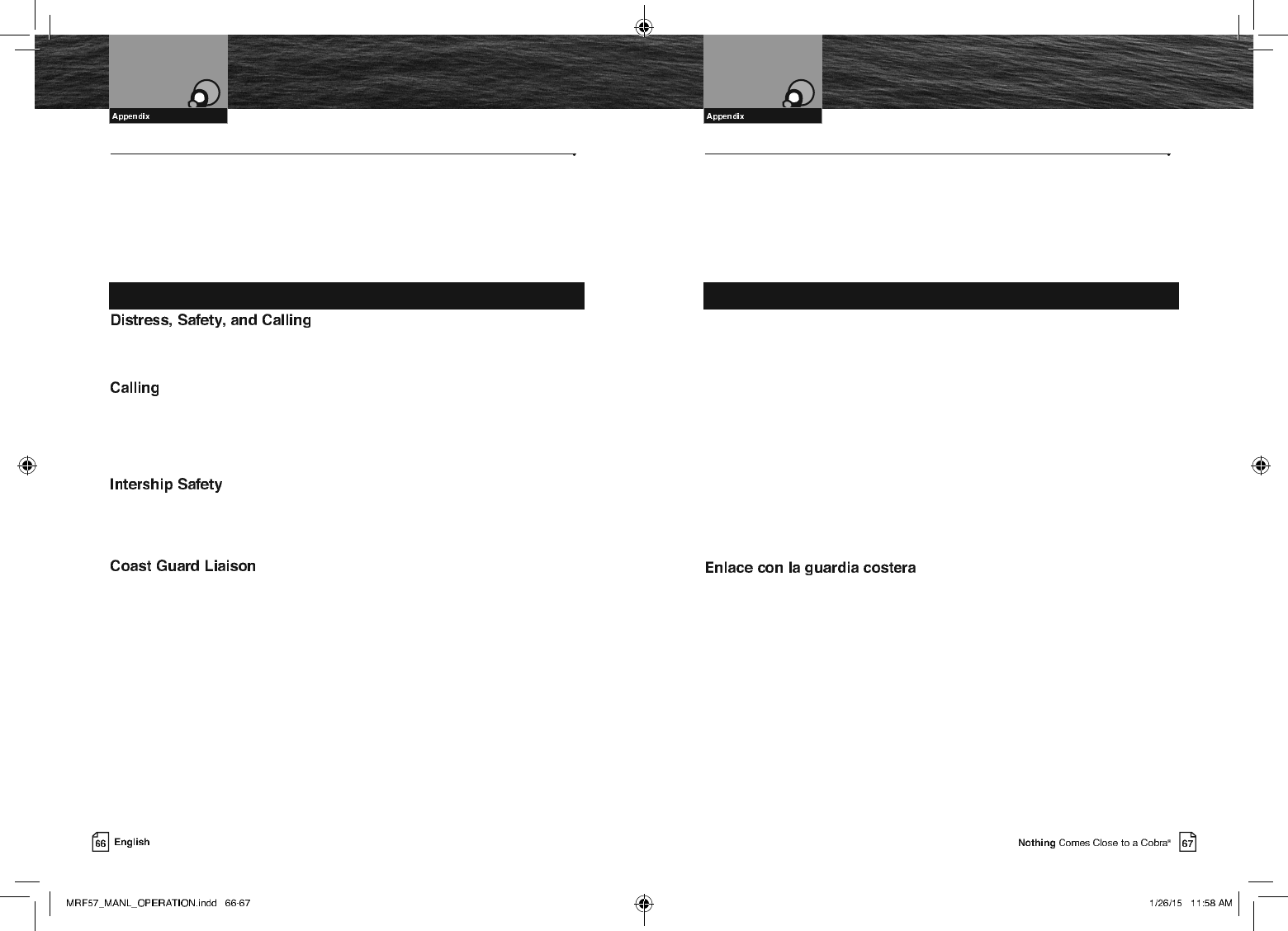
9+)0DULQH
&KDQQHO$VVLJQPHQWV
9+)0DULQH
&KDQQHO$VVLJQPHQWV
VHF Marine Channel Assignments
Three (3) sets of VHF channels have been established for marine use in the U.S.A.,
Canada and the rest of the world (International). Most of the channels are the same for
all three (3) maps, but there are denite differences (see table on the following pages).
Your radio has all three (3) maps built into it and will operate correctly in whichever
area you choose.
The following is a brief outline of the channel assignments in the U.S.A. Channel Map.
Channel 16
Getting the attention of another station (calling) or in emergencies (distress and safety).
Channel 9
General-purpose (non-emergency) calling by non-commercial vessels. Recreational boaters are
urged to use this channel to reduce congestion on Channel 16.
Channel 6
Ship-to-ship safety messages and for search and rescue messages to Coast Guard ships
and aircraft.
Channel 22A
To talk to the Coast Guard, Canadian Coast Guard (non-emergency) after making contact on
Channel 16.
1RQ&RPPHUFLDO
Channels 68*, 69, 71, 72, 78A, 79A*, 80A*
Working channels for small vessels. Messages must be about needs of the vessel, such as shing
reports, berthing and rendezvous. Use Channel 72 only for ship-to-ship messages.
&RPPHUFLDO
Channels 1A, 7A, 8, 9, 10, 11, 18A, 19A, 63A, 67, 72, 79A, 80A, 88A*
Working channels for working ships only. Messages must be about business or needs
of the ship. Use Channels 8, 67, 72 and 88A only for ship-to-ship messages.
&KDQQHO$VVLJQPHQWV(QJOLVK $VLJQDFLRQHVGHFDQDOHV(VSDxRO
Asignación de canales de VHF para radiocomunicación marítima
Existen tres (3) juegos de canales VHF para uso marítimo en los EE.UU., Canadá y
el resto del mundo (internacional). La mayoría de los canales coinciden en los tres
(3) mapas, pero sin duda existen diferencias (consulte las tablas en las páginas
siguientes). El radio incorpora los tres (3) mapas y funcionará correctamente en
cualquiera de las tres áreas.
A continuación presentamos en forma resumida las asignaciones de canales del
Mapa de canales para EE.UU.
$X[LOLRVHJXULGDG\OODPDGDV
Canal 16
Para ser oídos por otra estación (llamadas) o en casos de emergencia (auxilio y seguridad).
/ODPDGDV
Canal 9
Llamadas de carácter general (excepto casos de emergencia) para embarcaciones no comerciales.
Se le pide encarecidamente a la tripulación de las embarcaciones recreativas usar este canal
para reducir la congestión del canal 16.
6HJXULGDGHQWUHHPEDUFDFLRQHV
Canal 6
Para mensajes de seguridad entre embarcaciones y para mensajes de búsqueda y rescate
enviados a barcos y aviones de la guardia costera.
Canal 22A
Para hablar con las guardias costeras estadounidenses y canadienses (excepto casos de
emergencia) tras haber establecido contacto por el canal 16.
1RFRPHUFLDOHV
Canales 68*, 69, 71, 72, 78A, 79A*, 80A*
Canales activos para pequeñas embarcaciones. Los mensajes deberán estar relacionados con
necesidades de las embarcaciones, como por ejemplo, informes de pesca, atraques y agrupamientos.
Use el canal 72 solamente para mensajes entre embarcaciones.
&RPHUFLDOHV
Canales 1A, 7A, 8, 9, 10, 11, 18A, 19A, 63A, 67, 72, 79A, 80A, 88A*
Canales activos para embarcaciones activas solamente. Los mensajes deberán estar
relacionados con la actividad comercial o las necesidades de la embarcación. Use los
canales 8, 67, 72 y 88A solamente para mensajes entre embarcaciones.
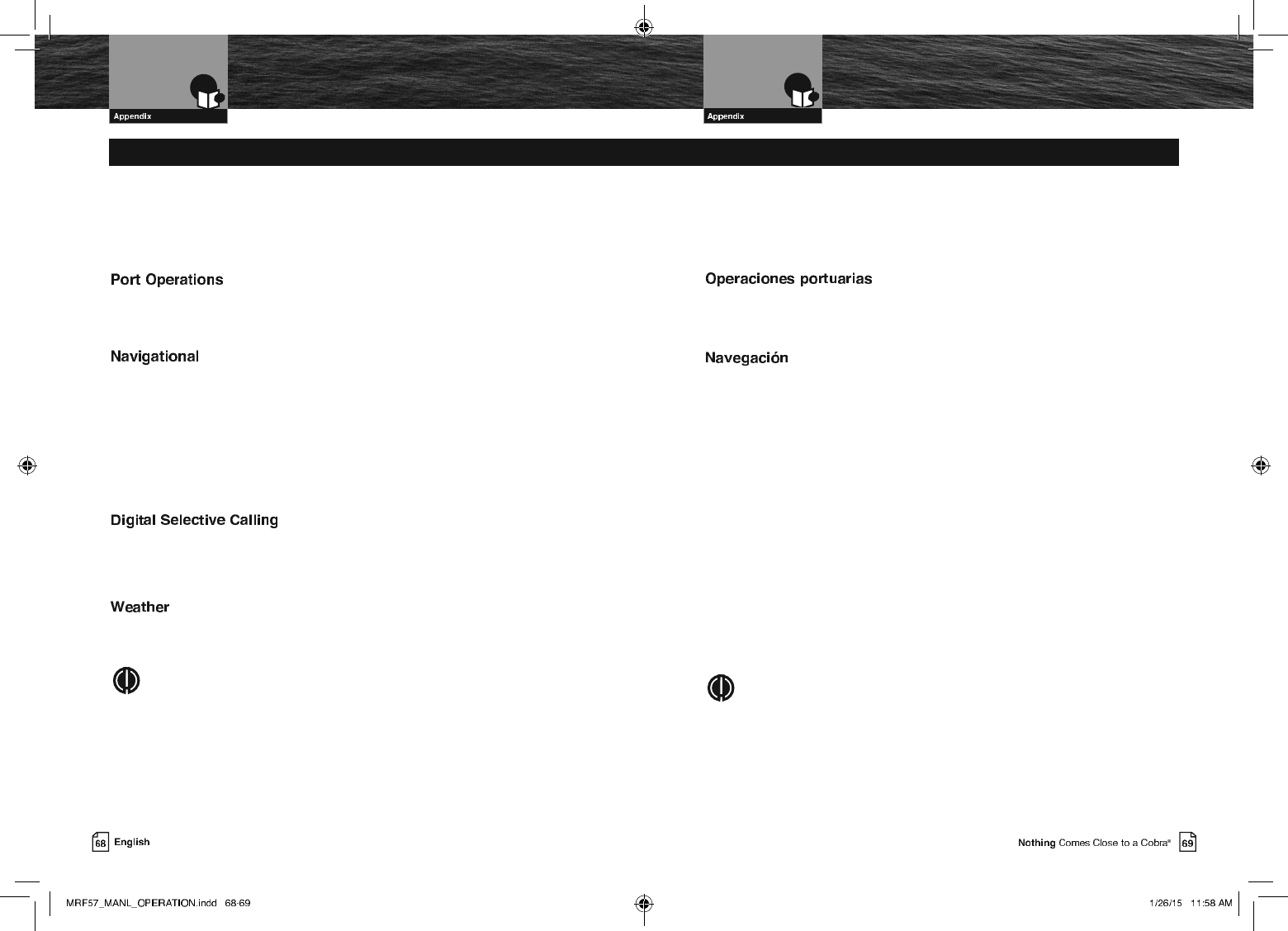
9+)0DULQH
&KDQQHO$VVLJQPHQWV
9+)0DULQH
&KDQQHO$VVLJQPHQWV
6HD7RZ$XWRPDWHG5DGLR&KHFN$5&
Channels 24, 25, 26, 27, 28, 84*
Tune your radio to the proper channel for your area (see seatow.com/arc). Conduct a radio check
as you normally would. Upon releasing the mic the system will replay your transmission letting
you hear how you sound.
Channels 1A*, 5A*, 12*, 14*, 18, 19, 20A, 21, 22, 63A*, 65A, 66A, 73, 74, 75, 76, 77*, 79, 80, 81, 82
Used for directing the movement of ships in or near ports, locks or waterways. Messages
must be about operational handling, movement and safety of ships.
Channels 13, 67
Channels are available to all vessels. Messages must be about navigation, including passing
or meeting other vessels. These are also the main working channels for most locks and
drawbridges. You must keep your messages short and power output at no more than 1 watt.
0DULWLPH&RQWURO
Channel 17
For talking to vessels and coast stations operated by state or local governments. Messages must
be about regulation and control, boating activities, or assistance.
Channel 70
This channel is set aside for distress, safety and general calling using only digital selective calling
techniques. Voice communication is prohibited; your radio cannot transmit voice messages on this
channel.
Channels Wx 1 Thru 10
Receive-only channels for NOAA and Canadian weather broadcasts. You cannot transmit on these
channels.
NOTE
* These channels are restricted to the listed uses in certain parts of the country
or for certain types of users only. Consult FCC rules or a knowledgeable radio
operator before using them.
&KDQQHO$VVLJQPHQWV(QJOLVK $VLJQDFLRQHVGHFDQDOHV(VSDxRO
6HD7RZ&RQWUROGHUDGLRDXWRPDWL]DGR$5&
Canales 24, 25, 26, 27, 28, 84*
Sintonice su radio en el canal correcto para su área (ver seatow.com/arc). Llevar a cabo una
comprobación de la radio como lo haría normalmente. Al soltar el micrófono el sistema se volverá
a reproducir la transmisión que le permite escuchar cómo suena.
Canales 1A*, 5A*, 12*, 14*, 18, 19, 20A, 21, 22, 63A*, 65A, 66A, 73, 74, 75, 76, 77*, 79, 80, 81, 82
Usados para dirigir el movimiento de las embarcaciones dentro de áreas portuarias, esclusas o
canales. Los mensajes deberán estar relacionados con maniobras operacionales, movimientos
y seguridad de las embarcaciones.
Canales 13, 67
Estos canales están disponibles para todas las embarcaciones. Los mensajes deberánestar relacionados
con la navegación, incluidas las maniobras para pasar o alcanzar otrasembarcaciones. Éstos también
son los principales canales activos para la mayoría de las esclusas y puentes levadizos. Usted deberá
transmitir mensajes cortos y mantener la potencia de salida en un vatio como máximo.
&RQWUROPDUtWLPR
Canal 17
Para comunicarse con embarcaciones y estaciones costeras operadas por entidades
gubernamentales locales o estatales. Los mensajes deberán estar relacionados con regulación y
control, asistencia o actividades de navegación.
/ODPDGDVVHOHFWLYDVGLJLWDOHV
Canal 70
Este canal está reservado para solicitudes de auxilio, seguridad y llamadas de carácter general
que usen solamente técnicas de llamadas selectivas digitales. Las comunicaciones verbales están
prohibidas; el radio no puede transmitir mensajes de voz por este canal.
0HWHRURORJtD
Canales Wx 1 a 10
Canales de recepción únicamente para difusión de información meteorológica NOAA y canadiense.
Usted no puede transmitir por estos canales.
NOTA
* El uso de estos canales está dedicado a las aplicaciones que aparecen en la lista, en
ciertas partes del país o para ciertos tipos de usuario solamente. Consulte las normas de
la FCC o a un operador de radio con experiencia antes de usarlos.
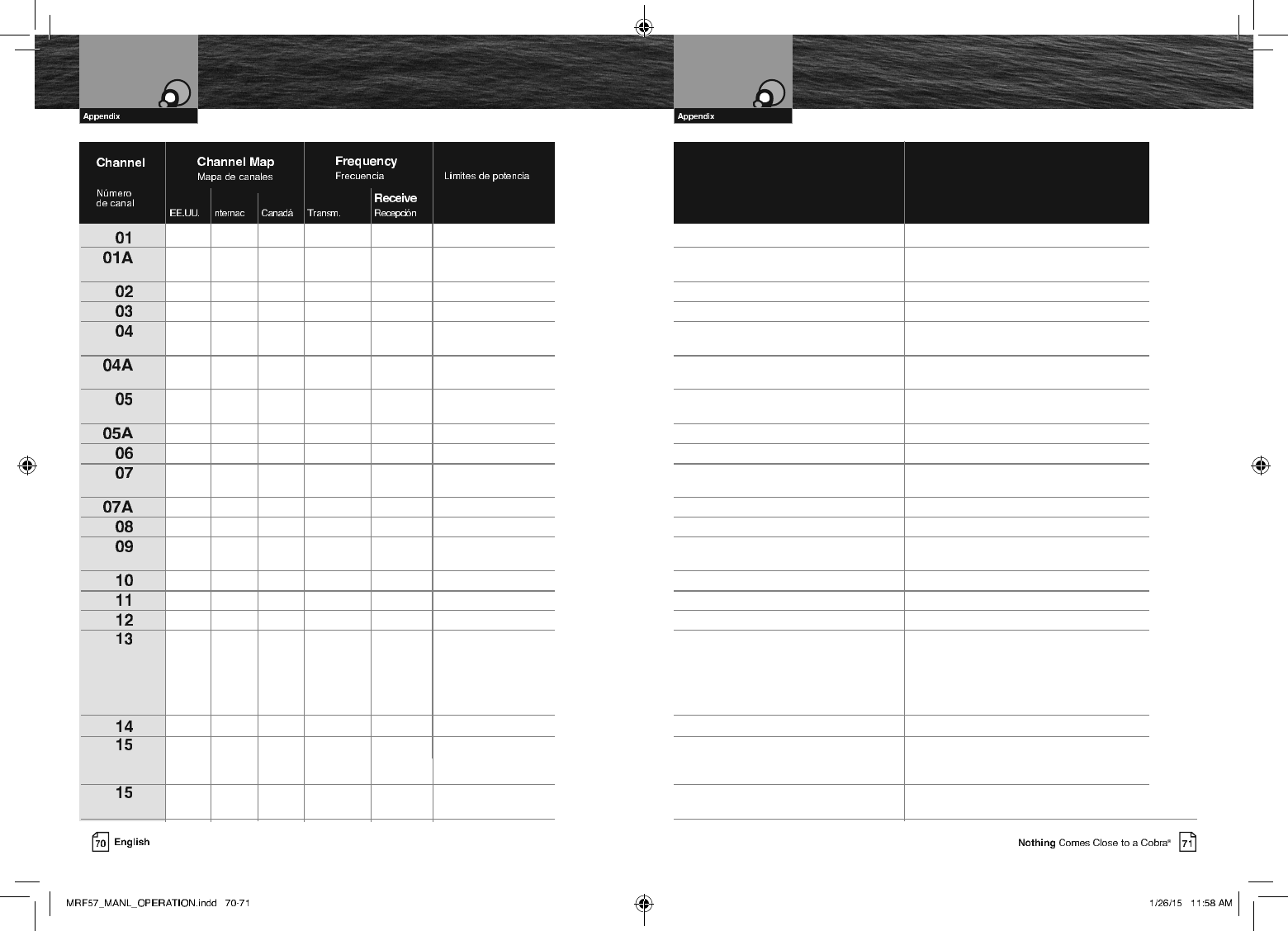
9+)0DULQH
&KDQQHO$VVLJQPHQWV
9+)0DULQH
&KDQQHO$VVLJQPHQWV
• • 156.050 160.650 Public Correspondence (Marine Operator) Correspondencia pública (operador marítimo)
• 156.050 156.050 Port Operations and Commercial, Operaciones portuarias y comerciales;
VTS in selected areas VTS en áreas selectas
• • 156.100 160.700 Public Correspondence (Marine Operator) Correspondencia pública (operador marítimo)
• • 156.150 160.750 Public Correspondence (Marine Operator) Correspondencia pública (operador marítimo)
• 156.200 160.800 Public Correspondence (Marine Operator), Correspondencia pública (operador marítimo)
Port Operations, Ship Movement operaciones portuarias,movimiento de embarcaciones
• 156.200 156.200 West Coast (Coast Guard Only); Costa occidental (guardia costera solamente);
East Coast (Commercial Fishing) Costa oriental (pesca comercial)
• 156.250 160.850 Public Correspondence (Marine Operator), Correspondencia pública (operador marítimo)
Port Operations, Ship Movement operaciones portuarias,movimiento de embarcaciones
• • 156.250 156.250 Port Operations, VTS in selected areas Operaciones portuarias; VTS en áreas selectas
• • • 156.300 156.300 Intership Safety Seguridad entre embarcaciones
• 156.350 160.950 Public Correspondence (Marine Operator), Correspondencia pública (operador marítimo)
Port Operations, Ship Movement operaciones portuarias,movimiento de embarcaciones
• • 156.350 156.350 Commercial Comerciales
• • • 156.400 156.400 Commercial (Intership Only) Comercial (entre embarcaciones solamente)
• • • 156.450 156.450 Boater Calling Channel, Canal de llamada de la tripulación,
Non-Commercial (Recreational) no comercial (recreativo)
• • • 156.500 156.500 Commercial Comerciales
• • • 156.550 156.550 Commercial, VTS in selected areas Comercial; VTS en áreas selectas
• • • 156.600 156.600 Port Operations, VTS in selected areas Operaciones portuarias; VTS en áreas selectas
• • • 156.650 156.650 1 watt USA Intership Navigation Safety (Bridge-to-Bridge).
In U.S. waters, large vessels maintain a
listening watch on this channel.
• • • 156.700 156.700 Port Operations, VTS in selected areas Operaciones portuarias; VTS en áreas selectas
• Rx Only 156.750 Environmental (Receive Only). Medioambiental (recepción solamente).
Usado por radiobalizas de localización
de siniestros (EPIRB) clase C
• 156.750 156.750 1 watt CANADA Canada (EPIRB Buoys Only); International Canadá (boyas de EPIRB solamente);
(On-Board Communication) Internacional (comunicación de a bordo)
&KDQQHO8VH(QJOLVK8VRGHFDQDOHV(VSDxRO
1XPEHU
3RZHU/LPLWV
1 vatio EE.UU. y Canadá Seguridad marítima entre embarcaciones (de
puente de mando a puente de mando). En aguas
estadounidenses, las grandes embarcaciones se
mantienen vigilantes con sus radios sintonizados
en este canal
86$ ,QW·O &DQDGD 7UDQVPLW
1 vatio Canadá
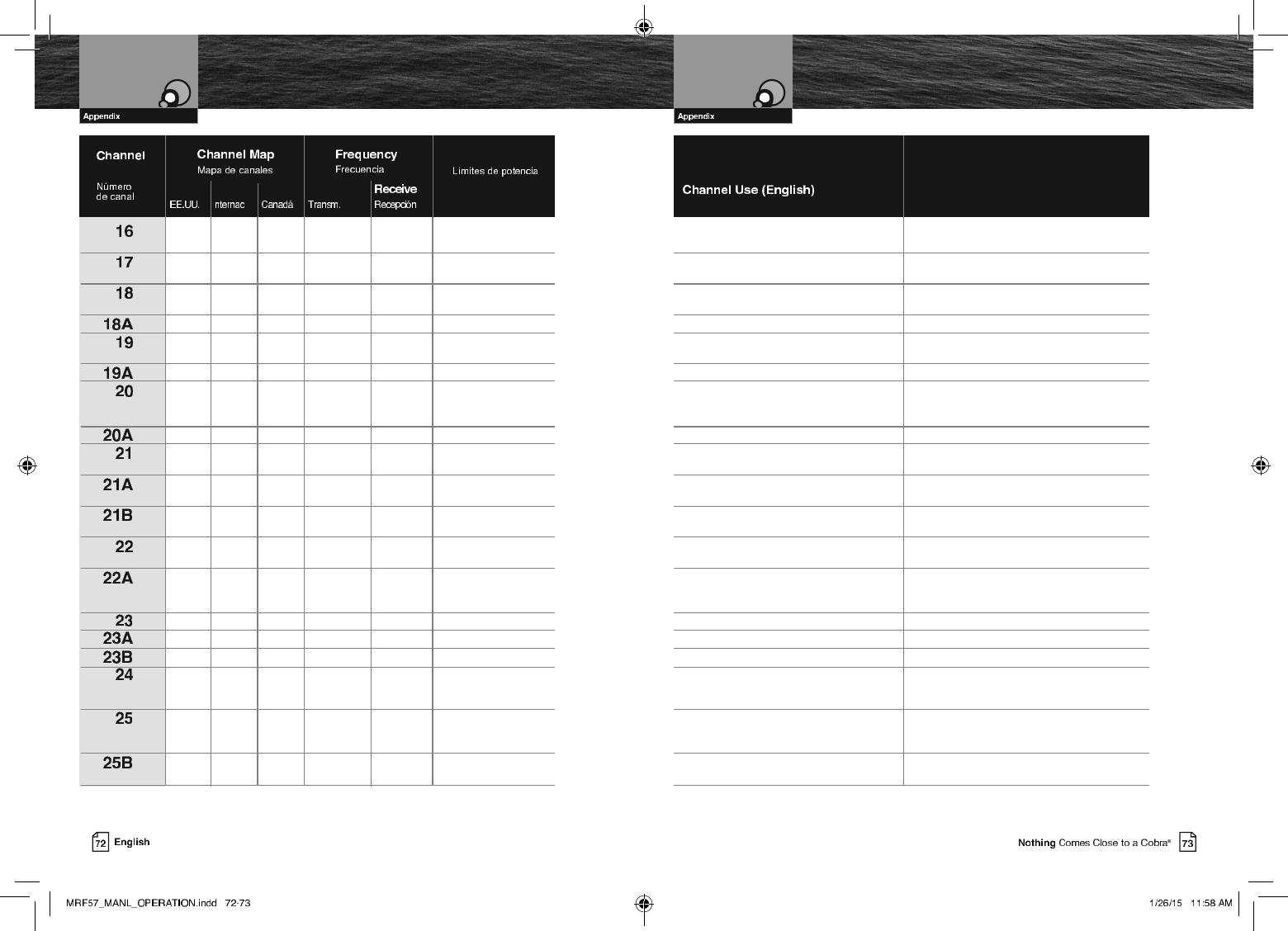
9+)0DULQH
&KDQQHO$VVLJQPHQWV
9+)0DULQH
&KDQQHO$VVLJQPHQWV
• • • 156.800 156.800 International Distress, Safety and Calling Llamadas, seguridad y solicitud
de auxilio internacional
• • • 156.850 156.850 1 watt CANADA Search and Rescue Búsqueda y rescate
• 156.900 161.500 Port Operations, Ship Movement Operaciones portuarias,
movimiento de embarcaciones
• • 156.900 156.900 Commercial Comerciales
• 156.950 161.550 Port Operations, Ship Movement Operaciones portuarias,
movimiento de embarcaciones
• • 156.950 156.950 Commercial Comerciales
• • • 157.000 161.600 1 watt CAN Canada (Coast Guard Only); International Canadá (guardia costera solamente);
(Port Operations, Ship Movement) Internacional (operaciones portuarias,
movimiento de embarcaciones)
• 157.000 157.000 Port Operations Operaciones portuarias
• 157.050 161.650 Port Operations, Ship Movement Operaciones portuarias,
movimiento de embarcaciones
• • 157.050 157.050 U.S. (Government Only); EE.UU. (entidades gubernamentales solamente);
Canada (Coast Guard Only) Canadá (guardia costera solamente)
• RX only 161.650 Coast Guard Only – Weather Broadcasts Solamente Guardacostas –
Transmisiones Meteorológicas
• 157.100 161.700 Port Operations, Ship Movement Operaciones portuarias,
movimiento de embarcaciones
• • 157.100 157.100 U.S. and Canadian Coast Guard Liaison and Enlace entre las guardias costeras
Maritime Safety Information Broadcasts that y canadienses, y difusión de información sobre
are announced on Channel 16 seguridad marítima anunciada por el canal 16
• • 157.150 161.750 Public Correspondence (Marine Operator) Correspondencia pública (operador marítimo)
• 157.150 157.150 Coast Guard Only Solamente Guardacostas
• RX Only 161.750 Coast Guard Only Solamente Guardacostas
• • • 157.200 161.800 Sea Tow Automated Radio Check Service
Sea Tow Servicio de radio automatizado del control
Public Correspondence (Marine Operator), Correspondencia pública (operador marítimo),
Port Operations, Ship Movement operaciones portuarias, movimiento de embarcaciones
• • • 157.250 161.850 Sea Tow Automated Radio Check Service
Sea Tow Servicio de radio automatizado del control
Public Correspondence (Marine Operator), Correspondencia pública (operador marítimo),
Port Operations, Ship Movement operaciones portuarias, movimiento de embarcaciones
• RX only 161.850 Safety: Continuous Marine Broadcast (CMB) Seguridad: Transmisión Marítima Continua (CMB)
service by MCTS Canada servicio por MCTS Canadá
8VRGHFDQDOHV(VSDxRO
1XPEHU
86$ ,QW·O &DQDGD 7UDQVPLW
1 vatio Canadá y Internac
1 vatio Canadá
3RZHU/LPLWV
1 vatio Canadá
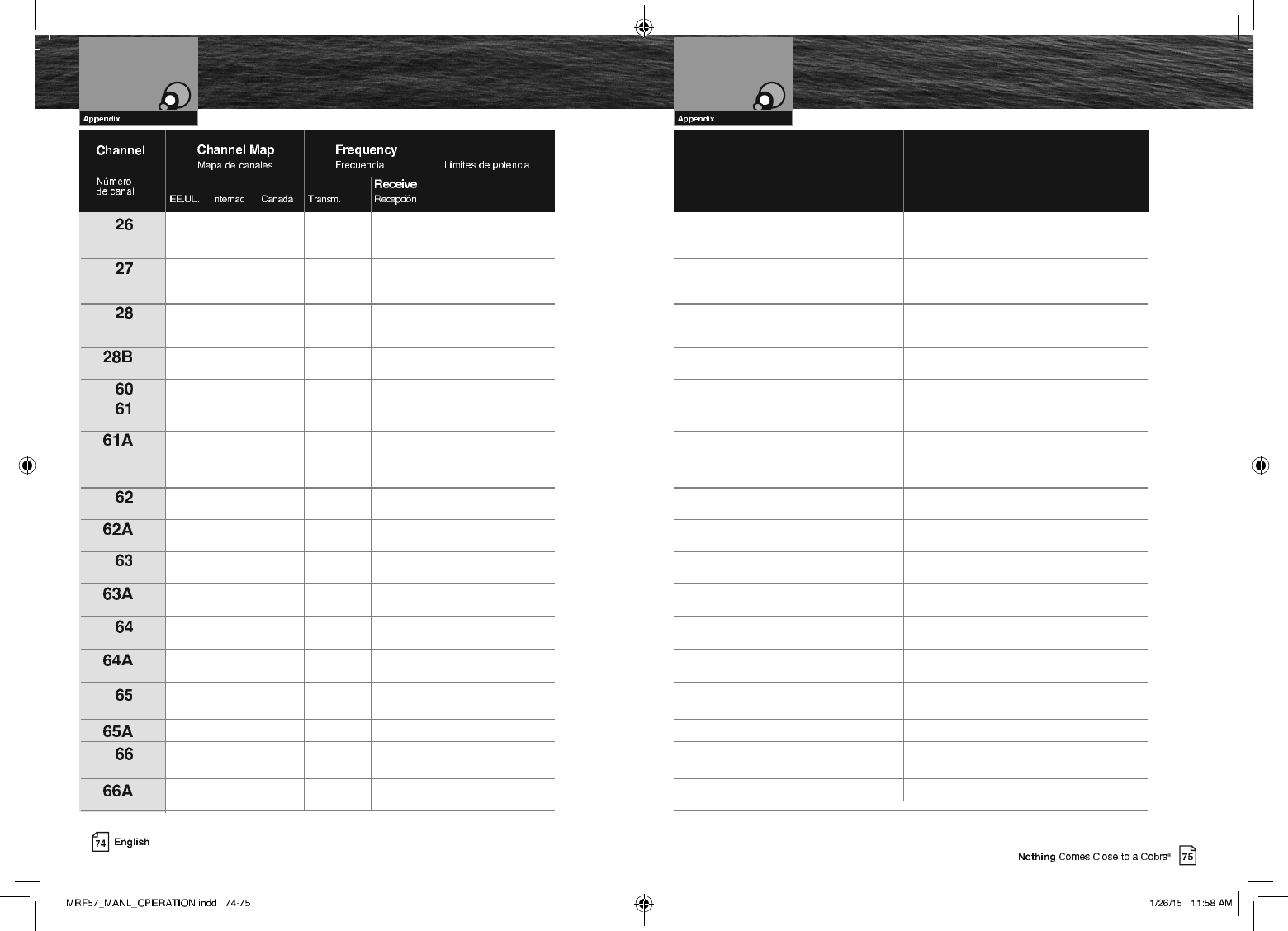
9+)0DULQH
&KDQQHO$VVLJQPHQWV
9+)0DULQH
&KDQQHO$VVLJQPHQWV
• • • 157.300 161.900 Sea Tow Automated Radio Check Service
Sea Tow Servicio de radio automatizado del control
Public Correspondence (Marine Operator), Correspondencia pública (operador marítimo),
Port Operations, Ship Movement operaciones portuarias, movimiento de embarcaciones
• • • 157.350 161.950 Sea Tow Automated Radio Check Service
Sea Tow Servicio de radio automatizado del control
Public Correspondence (Marine Operator), Correspondencia pública (operador marítimo),
Port Operations, Ship Movement operaciones portuarias, movimiento de embarcaciones
• • • 157.400 162.000 Sea Tow Automated Radio Check Service
Sea Tow Servicio de radio automatizado del control
Public Correspondence (Marine Operator), Correspondencia pública (operador marítimo),
Port Operations, Ship Movement operaciones portuarias, movimiento de embarcaciones
• RX only 162.000 Safety: Continuous Marine Broadcast (CMB) Seguridad: Transmisión Marítima Continua (CMB)
service by MCTS Canada servicio por MCTS Canadá
• • 156.025 160.625 Public Correspondence (Marine Operator) Correspondencia pública (operador marítimo)
• 156.075 160.675 Public Correspondence (Marine Operator) Correspondencia pública (operador marítimo),
Port Operation, Ship Movement operaciones portuarias, movimiento de embarcaciones
• 156.075 156.075 U.S. (Government Only); Canada (Coast
Guard Only); West Coast (Coast Guard
Only); East Coast (Commercial Fishing)
• 156.125 160.725 Public Correspondence (Marine Operator), Correspondencia pública (operador marítimo),
Port Operations, Ship Movement operaciones portuarias, movimiento de embarcaciones
• 156.125 156.125 West Coast (Coast Guard Only); Costa occidental (guardia costera
East Coast (Commercial Fishing) solamente); Costa oriental (pesca comercial)
• 156.175 160.775 Public Correspondence (Marine Operator), Correspondencia pública (operador marítimo),
Port Operations, Ship Movement operaciones portuarias, movimiento de embarcaciones
• • 156.175 156.175 Port Operations and Commercial, Operaciones portuarias y comerciales;
VTS in selected areas VTS en áreas selectas
• • 156.225 160.825 Public Correspondence (Marine Operator), Correspondencia pública (operador marítimo),
Port Operations, Ship Movement operaciones portuarias, movimiento de embarcaciones
• 156.225 156.225 U.S. (Government Only); EE.UU. (entidades gubernamentales
Canada (Commercial Fishing) solamente); Canadá (pesca comercial)
• 156.275 160.875 Public Correspondence (Marine Operator), Correspondencia pública (operador marítimo),
Port Operations, Ship Movement operaciones portuarias, movimiento de embarcaciones
• • 156.275 156.275 Port Operations Operaciones portuarias
• 156.325 160.925 Public Correspondence (Marine Operator), Correspondencia pública (operador marítimo),
Port Operations, Ship Movement operaciones portuarias, movimiento de embarcaciones
• • 156.325 156.325 1 watt CAN Port Operations Operaciones portuarias
&KDQQHO8VH(QJOLVK8VRGHFDQDOHV(VSDxRO
1XPEHU
3RZHU/LPLWV
86$ ,QW·O &DQDGD 7UDQVPLW
EE.UU. (entidades gubernamentales
solamente); Canadá (guardia costera
solamente); Costa occidental (guardia costera
solamente); Costa oriental (pesca comercial)
1 vatio Canadá
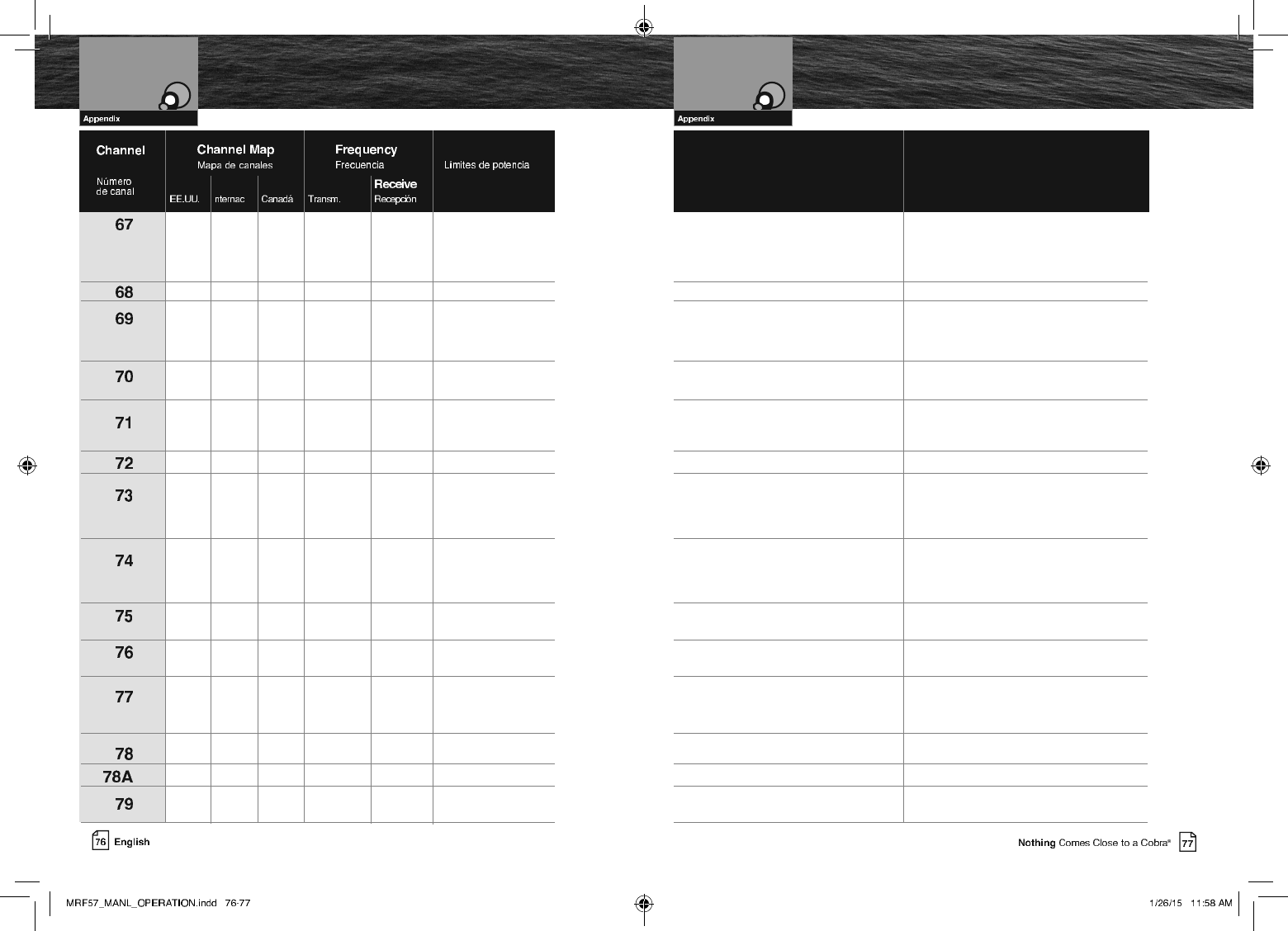
9+)0DULQH
&KDQQHO$VVLJQPHQWV
9+)0DULQH
&KDQQHO$VVLJQPHQWV
• • • 156.375 156.375 1 watt USA
• • • 156.425 156.425 Non-Commercial (Recreational) No comercial (recreativo)
• • • 156.475 156.475 U.S. (Non-Commercial, Recreational); Canada
(Commercial Fishing Only); International
(Intership, Port Operations, Ship Movement)
• • • RX only 156.525 Digital Selective Calling Llamadas selectivas digitales (las comunicaciones
(Voice communications not allowed) verbales están prohibidas).
• • • 156.575 156.575 1 watt USA U.S. and Canada (Non-Commercial, Recreational); EE.UU. y Canadá (no comercial, recreativo);
International (Port Operations, Ship Movement) Internacional (operaciones portuarias,
movimiento de embarcaciones).
• • • 156.625 156.625 Non-Commercial (Intership Only) No comercial (entre embarcaciones solamente).
• • • 156.675 156.675
U.S. (Port Operations); Canada (Commercial EE.UU. (operaciones portuarias); Canadá (pesca
Fishing Only); International (Intership, comercial solamente); Internacional (comunicaciones
Port Operations, Ship Movement) entre embarcaciones, operaciones portuarias,
movimiento de embarcaciones).
• • • 156.725 156.725 U.S. (Port Operations); Canada (Commercial EE.UU. (operaciones portuarias); Canadá (pesca
Fishing Only); International (Intership, comercial solamente); Internacional (comunicaciones
Port Operations, Ship Movement) entre embarcaciones, operaciones portuarias,
movimiento de embarcaciones).
• • • 156.775 156.775 1 watt Port Operations (Intership Only) Operaciones portuarias
(entre embarcaciones solamente).
• • • 156.825 156.825 1 watt Port Operations (Intership Only) Operaciones portuarias
(entre embarcaciones solamente).
• • • 156.875 156.875 1 watt USA
Port Operations (Intership only). Restricted to Operaciones portuarias (entre embarcaciones
communications with pilots for movement and solamente). Restringido a comunicaciones con
docking of ships. pilotos para el movimiento y atraque de
embarcaciones.
• 156.925 161.525 Public Correspondence (Marine Operator) Correspondencia pública (operador marítimo).
• • 156.925 156.925 Non-Commercial (Recreational) No comercial (recreativo).
• 156.975 161.575 Port Operations, Ship Movement Operaciones portuarias,
movimiento de embarcaciones.
&KDQQHO8VH(QJOLVK8VRGHFDQDOHV(VSDxRO
1XPEHU
3RZHU/LPLWV
86$ ,QW·O &DQDGD 7UDQVPLW
EE.UU. (entidades gubernamentales
solamente); Canadá (guardia costera
solamente); Costa occidental (guardia costera
solamente); Costa oriental (pesca comercial)
1 vatio Canadá
1 vatio EE.UU
1 vatio
1 vatio
1 vatio EE.UU
Internship Navigation Safety (Bridge-to-Bridge).
In U.S. waters, large vessels maintain a listening
watch on thias channel.
Seguridad marítima entre embarcaciones (de
puente de mando a puente de mando). En aguas
estadounidenses, las grandes embarcaciones se
mantienen vigilantes con sus radios sintonizados en
este canal.
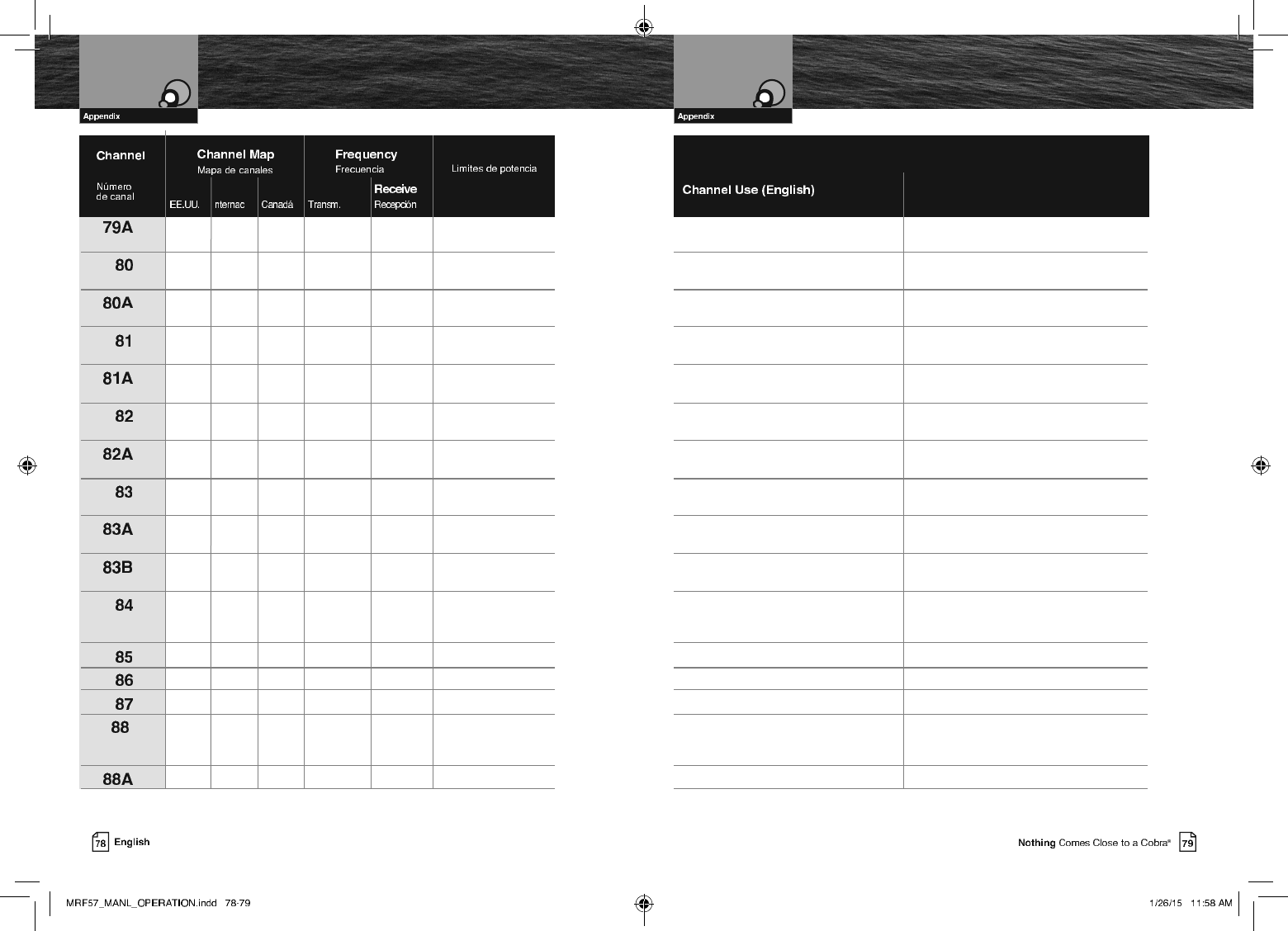
9+)0DULQH
&KDQQHO$VVLJQPHQWV
9+)0DULQH
&KDQQHO$VVLJQPHQWV
• • 156.975 156.975 Commercial (Also Non-Comercial Comercial (en los Grandes
only in Great Lakes) Lagos también no comercial)
• 157.025 161.625 Port Operations, Ship Movement Operaciones portuarias,
movimiento de embarcaciones
• • 157.025 157.025 Commercial (Also Non-Commercial Comercial (en los Grandes
only in Great Lakes) Lagos también no comercial)
• 157.075 161.675 Port Operations, Ship Movement Operaciones portuarias,
movimiento de embarcaciones
• • 157.075 157.075 U.S. (Government Only); Canada EE.UU. (entidades gubernamentales solamente);
(Coast Guard Only) Canadá (guardia costera solamente)
• 157.125 161.725 Public Correspondence (Marine Operator) Correspondencia pública (operador marítimo)
Port Operation, Ship Movement operaciones portuarias, movimiento de embarcaciones
• • 157.125 157.125 U.S. (Government Only); Canada EE.UU. (entidades gubernamentales solamente);
(Coast Guard Only) Canadá (guardia costera solamente)
• 157.175 161.775 Public Correspondence (Marine Operator) Correspondencia pública (operador marítimo)
Port Operation, Ship Movement operaciones portuarias, movimiento de embarcacione
• • 157.175 157.175 U.S. (Government Only); Canada EE.UU. (entidades gubernamentales solamente);
(Coast Guard Only) Canadá (guardia costera solamente)
• RX only 161.775 Coast Guard Only – Weather Broadcasts Solamente Guardacostas –
Transmisiones Meteorológicas
• • • 157.225 161.825 Sea Tow Automated Radio Check Service
Sea Tow Servicio de radio automatizado del control
Public Correspondence (Marine Operator) Correspondencia pública (operador marítimo)
Port Operation, Ship Movement operaciones portuarias, movimiento de embarcaciones
• • • 157.275 161.875 Public Correspondence (Marine Operator) Correspondencia pública (operador marítimo)
• • • 157.325 161.925 Public Correspondence (Marine Operator) Correspondencia pública (operador marítimo)
• • • 157.375 157.375 Public Correspondence (Marine Operator) Correspondencia pública (operador marítimo)
• • • 157.425 157.425 Public Correspondence (Ship to Coast). Correspondencia pública (entre embarcación y costa).
In U.S. only within 75 miles of Canadian Border. En los EE.UU., solamente dentro de los casi
121 kilómetros (75 millas) de la frontera canadiense
• 157.425 157.425 Commercial Intership only Comercial entre embarcaciones solamente
8VRGHFDQDOHV(VSDxRO
1XPEHU
86$ ,QW·O &DQDGD 7UDQVPLW
3RZHU/LPLWV
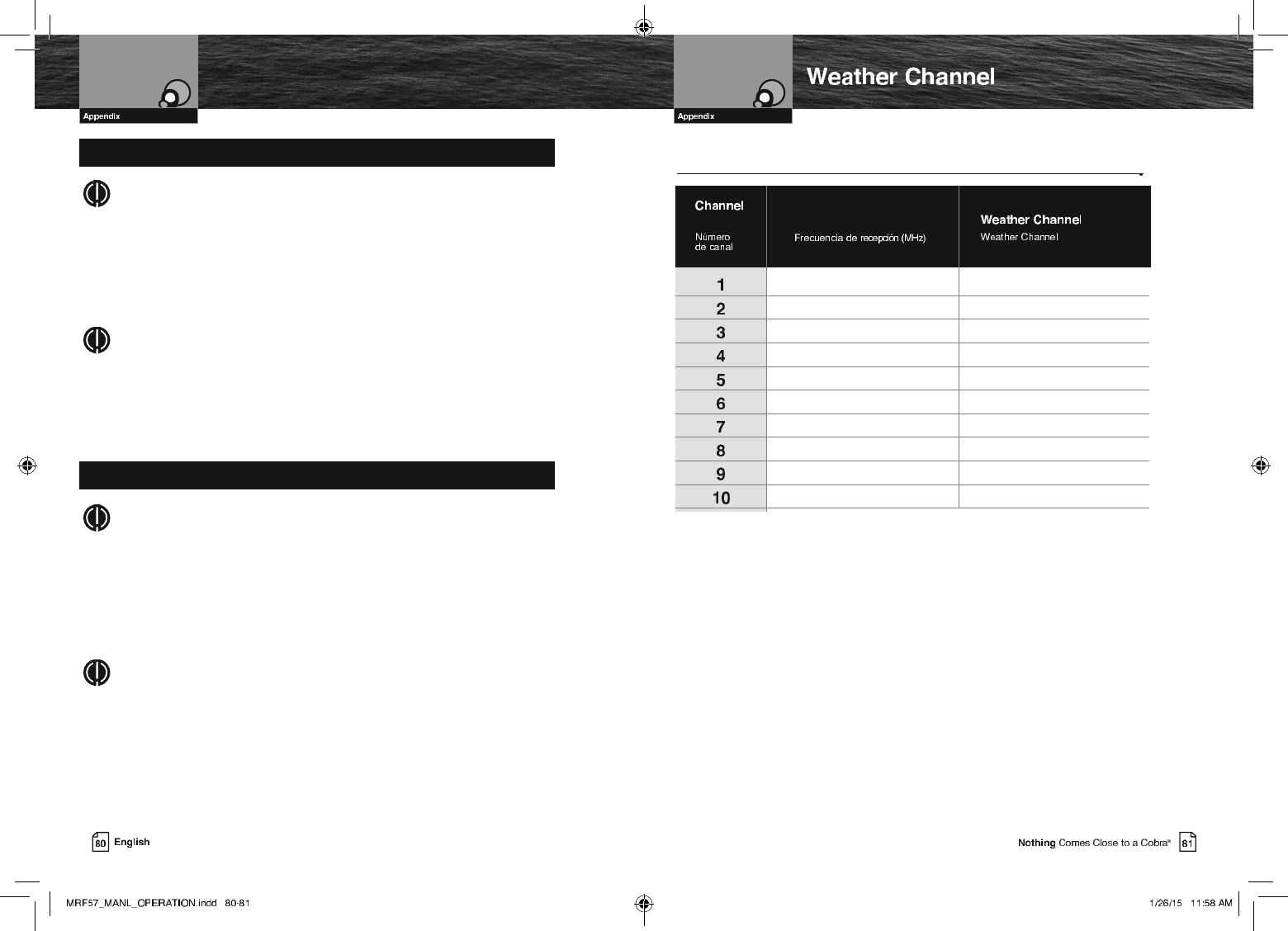
$VVLJQPHQWV
9+)0DULQH
&KDQQHO$VVLJQPHQWV
NOTE
Many of the plain-numbered channels, such as 01, 02 and 03, transmit and
receive on different frequencies. This is termed duplex operation. The rest of the
plain-numbered channels and all of the A channels, such as 01A, 03A and
04A, transmit and receive on a single frequency, which is termed simplex
operation. Your radio automatically adjusts to these conditions. When in simplex
operation, the A icon will appear on the LCD (see illustration on page A3).
NOTE
All channels are preprogrammed at the factory according to international
regulations and those of the FCC (U.S.A.) and Industry Canada (Canada).
They cannot be altered by the user nor can modes of operation be changed
between simplex and duplex.
NOTA
Muchos de los canales de números simples, como 01, 02 y 03, transmiten
y reciben en diferentes frecuencias. A esto se le llama operación dúplex. El
resto de los canales de números simples y todos los canales A, como 01A,
03A y 04A, transmiten y reciben en una sola frecuencia, a la que se le llama
operación simple (simplex). Su radio se ajusta automáticamente a estas
condiciones. Cuando esté en operación simple, el icono A aparecerá en la
pantalla de cristal líquido (vea la ilustración de la página A3).
NOTA
Todos los canales vienen programados previamente de fábrica conforme
a los reglamentos internacionales y a los de la FCC (EE. UU) e Industry Canada
(Canadá). No pueden ser alterados por el usuario, así como tampoco pueden
cambiarse los modos de operación entre simple y dúplex.
Weather Channel Assignments
$VLJQDFLRQHVGHFDQDOHVPHWHRUROyJLFRV
5;)UHTXHQF\0+]
1XPEHU
162.550 NOAA
162.400 NOAA
162.475 NOAA
162.425 NOAA
162.450 NOAA
162.500 NOAA
162.525 NOAA
161.650 Canada
161.775 Canada
163.275 NOAA
9+)0DULQH&KDQQHO$VVLJQPHQWV(QJOLVK
$VLJQDFLyQGHFDQDOHVGH9+)SDUDUDGLRFRPXQLFDFLyQPDUtWLPD(VSDxRO
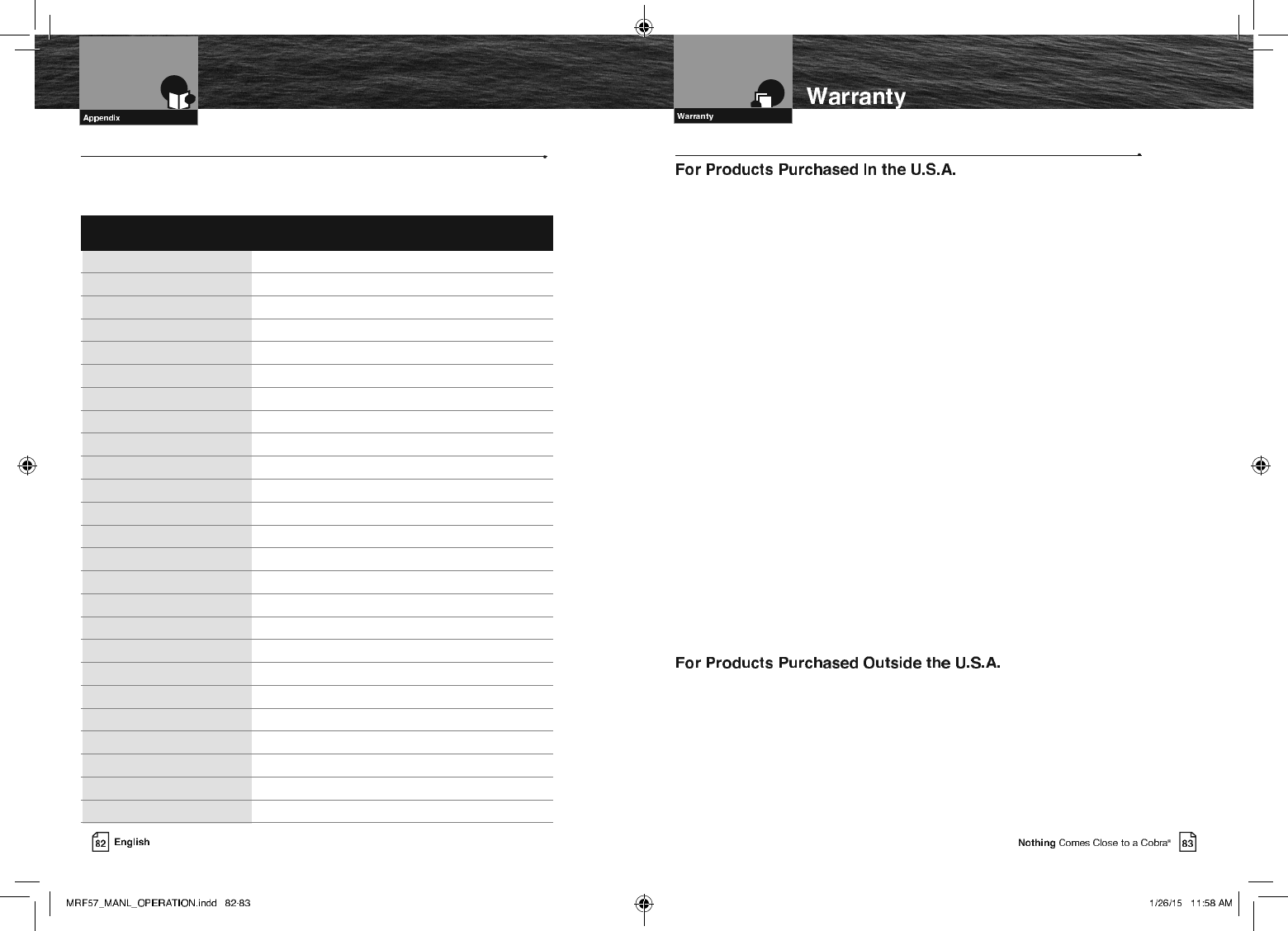
Limited 3-Year Warranty
Cobra® Electronics Corporation warrants that its CobraMarine VHF radio, and the
component parts thereof, will be free of defects in workmanship and materials
for a period of three (3) years from the date of rst consumer purchase. This
warranty may be enforced by the rst consumer purchaser, provided that the
product is utilized within the U.S.A.
Cobra® will, without charge, repair or replace, at its option, defective radios,
products or component parts upon delivery to the Cobra® Factory Service department,
accompanied by proof of the date of rst consumer purchase,
such as a duplicated copy of a sales receipt.
You must pay any initial shipping charges required to ship the product for warranty
service, but the return charges will be at Cobra®’s expense, if the product is repaired
or replaced under warranty. This warranty gives you specic legal rights, and you may
also have other rights which may vary from state to state.
Exclusions: This limited warranty does not apply:
1. To any product damaged by accident.
2. In the event of misuse or abuse of the product or as a result
of unauthorized alterations or repairs.
3. If the serial number has been altered, defaced, or removed.
4. If the owner of the product resides outside the U.S.A.
All implied warranties, including warranties of merchantability and tness for a
particular purpose are limited in duration to the length of this warranty. Cobra®
shall not be liable for any incidental, consequential or other damages; including,
without limitation, damages resulting from loss of use or cost of installation.
Some states do not allow limitations on how long an implied warranty lasts and/or do
not allow the exclusion or limitation of incidental or consequential damages,
so the above limitations may not apply to you.
Please contact your local dealer for warranty information.
:RUOG&LW\7LPH=RQHV
World City Time Zones
In order to set correct local time as compared to different World City Time Zones,
enter the hour “offset” as listed below. The correct local time appears on the VHF for
Cities all over the world. See page 43 for setup information.
/RQJLWXGLQDO=RQH 2IIVHW &LW\
E172.50 to W172.50 -12 IDLW (International Date Line West)
W172.50 to W157.50 -11 Nome
W157.50 to W142.50 -10 Honolulu
W142.50 to W127.50 -9 Yukon STD
W127.50 to W112.50 -8 Los Angeles STD
W112.50 to W097.50 -7 Denver STD
W097.50 to W082.50 -6 Chicago STD
W082.50 to W067.50 -5 New York STD
W067.50 to W052.50 -4 Caracas
W052.50 to W037.50 -3 Rio de Janeiro
W037.50 to W022.50 -2 Fernando de Noronha
W022.50 to W007.50 -1 Azores Islands
W007.50 to E007.50 GMT +0 London
E007.50 to E022.50 +1 Rome
E022.50 to E037.50 +2 Cairo
E037.50 to E052.50 +3 Moscow
E052.50 to E067.50 +4 Abu Dhabi
E067.50 to E082.50 +5 Maldives
E082.50 to E097.50 +6 Dhuburi
E097.50 to E112.50 +7 Bangkok
E112.50 to E127.50 +8 Hong Kong
E127.50 to E142.50 +9 Tokyo
E142.50 to E157.50 +10 Sydney
E157.50 to E172.50 +11 Solomon Islands
E172.50 to W172.50 +12 Auckland
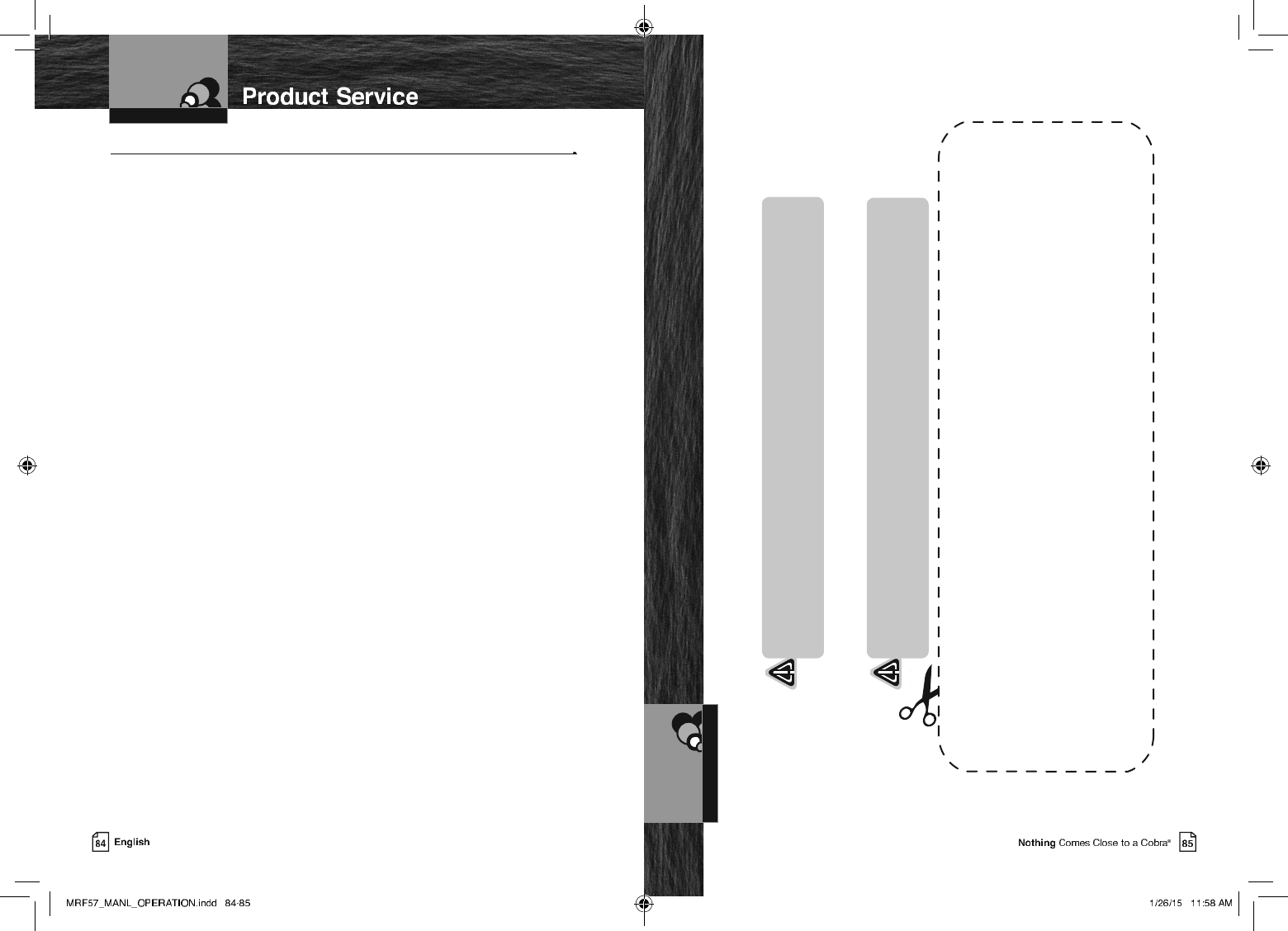
&XVWRPHU6HUYLFH
Product Service
,I\RXKDYHDQ\TXHVWLRQVDERXWRSHUDWLRQRULQVWDOOLQJ\RXU
QHZ&REUD0DULQH9+)SURGXFWRULI\RXDUHPLVVLQJSDUWV«
Please call Cobra rst! DO NOT RETURN THIS PRODUCT TO THE STORE!
See customer assistance on page A1.
If your product should require factory service, please call Cobra rst before sending
your radio. This will ensure the fastest turn-around time on your repair. You may
be asked to send your radio to the Cobra factory. It will be necessary to furnish the
following to have the product serviced and returned:
1. For warranty repair include some form of proof-of-purchase, such as a mechanical
reproduction or carbon of a sales receipt. If you send the original receipt, it cannot
be returned.
2. Send the entire product.
3. Enclose a description of what is happening with the radio. Include a typed
or clearly printed name and address of where the radio is to be returned.
4. Pack radio securely to prevent damage in transit. If possible, use the
original packing material.
5. Ship prepaid and insured by way of a traceable carrier such as United Parcel
Service (UPS) or Priority Mail to avoid loss in transit to: Cobra Factory Service,
Cobra Electronics Corporation, 6500 West Cortland Street, Chicago, Illinois 60707
U.S.A.
6. If the radio is in warranty, upon receipt of your radio it will either be repaired
or exchanged depending on the model. Please allow approximately three (3)
to four (4) weeks before contacting Cobra for status. If the radio is out of warranty,
a letter will automatically be sent informing you of the repair
charge or replacement charge.
If you have any questions, please call 773-889-3087 for assistance.
)OXVK0RXQW7HPSODWH3ODQWLOODSDUDPRQWDMHHPSRWUDGR
&XVWRPHU6HUYLFH
Use the supplied template to mark and cut an opening in the at surface.
CAUTION
Before cutting, be sure the area behind the at surface is clear of any instruments
or wires that might be damaged in the process.
Use la plantilla suministrada para marcar y cortar el agujero en la supercie plana.
PRECAUCIÓN
Antes de cortar, compruebe que no haya instrumentos o cables en el área detrás
de la supercie plana, que puedan resultar dañados durante el proceso.
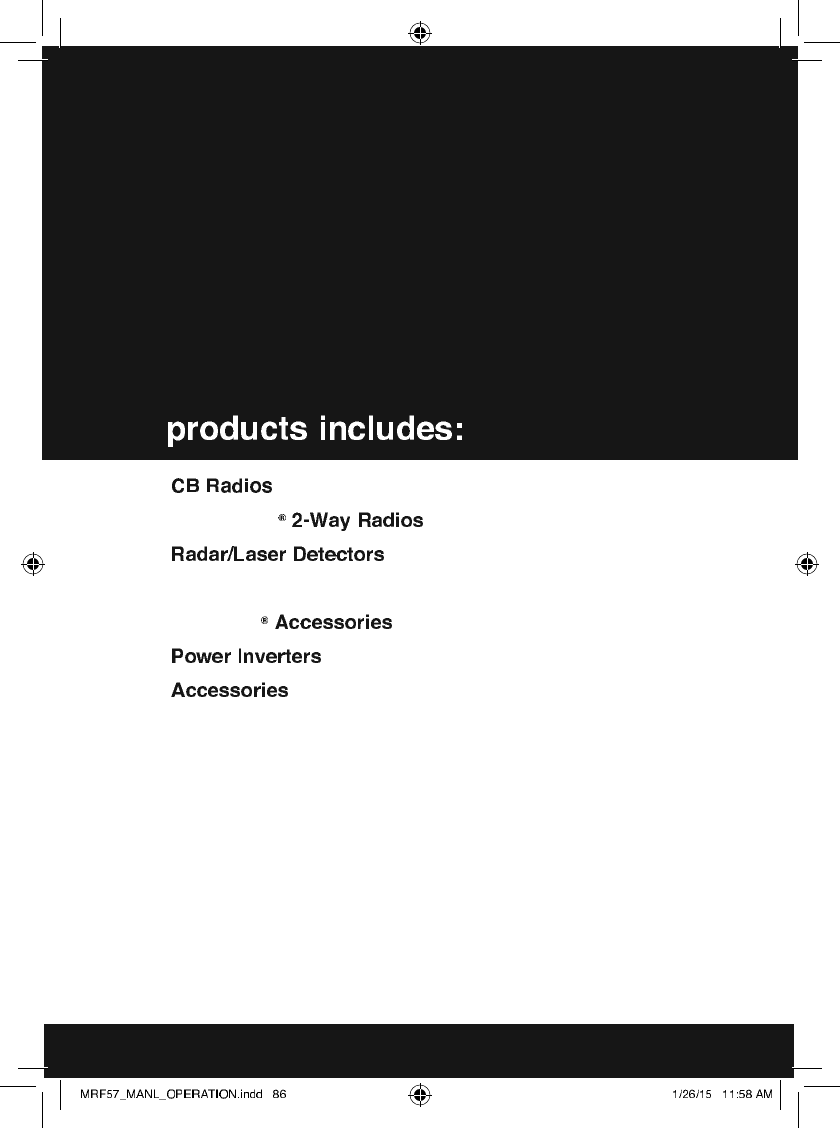
For more information or to
order any of our products,
please visit our website:
www.cobra.com
PLFUR7$/.
0RELOH*361DYLJDWLRQ6\VWHPV
+LJK*HDU
7KH&REUDOLQHRITXDOLW\
Nothing Comes Close to a Cobra®